Recent Storm Damage Posts
Restore Your Property and Belongings After a Flood
7/19/2024 (Permalink)
 Storm damage in Oklahoma City, OK
Storm damage in Oklahoma City, OK
Cleaning up after a flood in your Oklahoma City, OK, business can seem overwhelming, but with preparation and planning, you can steadily deal with the damage. Reach out to available resources and take the following content cleaning steps to get your business back on track.
Focus on Safety First
There are several significant risks when dealing with water in the workplace. Before you start any cleanup effort, protect yourself and those around you from potential hazards.
- Turn off the gas and electricity.
- Use appropriate protective gear, such as gloves, boots, and masks.
- Contact flood cleanup professionals immediately if you suspect black water.
- Remove water as quickly as possible.
Whether water trickled into your building or rushed in quickly, there's a potential for damage to the foundation, walls, floors, windows, and other structural components. Before stepping onto a weakened floor, make sure there aren't dangerous structural damages.
Document Water Damage for Your Insurance
After taking care of your first priorities, it's important to document damages for your insurance company. Take photographs or video of the damages to your building. These should be taken before you start to clean up any of the flood damage.
Identify DIY Work and Professional Work
You can take care of a lot of cleaning and damage, but some of the work should be completed by professionals. For example, soggy books and papers, damaged artwork, and furnishings may require the specialized care that professionals provide. Your insurance company may prefer that you turn all of the cleanup over to these technicians. Professional-strength cleaners and disinfectants remove layers of dirt and slow or prevent the growth of diseases from black water contamination.
There are many surfaces and materials in your building that require specialized content cleaning efforts. Protect your property from lasting damages, such as mold growth and structural damages, by taking prompt action, working with your insurance company, and determining which tasks to turn over to professionals.
What You Need To Know Before Cleaning Up Water Damage
6/25/2024 (Permalink)
 Commercial flooded basement in Arcadia,OK
Commercial flooded basement in Arcadia,OK
Water is an essential resource, but it can be destructive when it flows where it doesn’t belong. When water damages your business, it is important to determine the source of the problem. This discussion of three common sources may help you decide how to proceed with your structural and content cleaning.
Facility-Related Water
When damage is caused by a water source within your building, it may have originated from one of these sources:
- Your refrigerator or water heater leaks.
- A pipe carrying clean water bursts in your building.
- A dishwasher or specialized piece of equipment leaks water that may be contaminated with chemicals, soil or food.
- A toilet overflows or a sewer backs up, releasing sewage into your structure.
If the water potentially contains toxic chemicals or sewage, it is considered to be dangerous. Consulting a water remediation specialist will be required to safely facilitate the content cleaning and restoration. Facility-related damage is likely covered by your insurance, so contacting your agent promptly is recommended.
Stormwater
When hail, rain or snowmelt enters your building through a broken window or leaking roof, it is considered stormwater. If the water hasn’t touched the ground and is due to a weather event, it falls into this category. Stormwater damage generally requires a professional cleanup service as well as home repairs. Your business insurance will generally cover the expense for stormwater restoration.
Floodwater
If rising floodwater enters your building at ground level or below, it is termed black water and is considered highly contaminated. Floodwater can contain chemicals, sewage and other hazards. If you have flood-related damage, it is necessary to enlist a restoration specialist for the building and content cleaning process. For this water restoration cost to be covered, you would need to have purchased a separate insurance policy for flooding, prior to the incident.
When water from a flood or other source damages your Arcadia, OK, business, the origin of the water will determine the best cleanup plan and the type of insurance coverage that applies. It will take some time, but before you know it, your company will be back to business as usual.
Rainstorm Damages Your Edmund Home
4/8/2024 (Permalink)
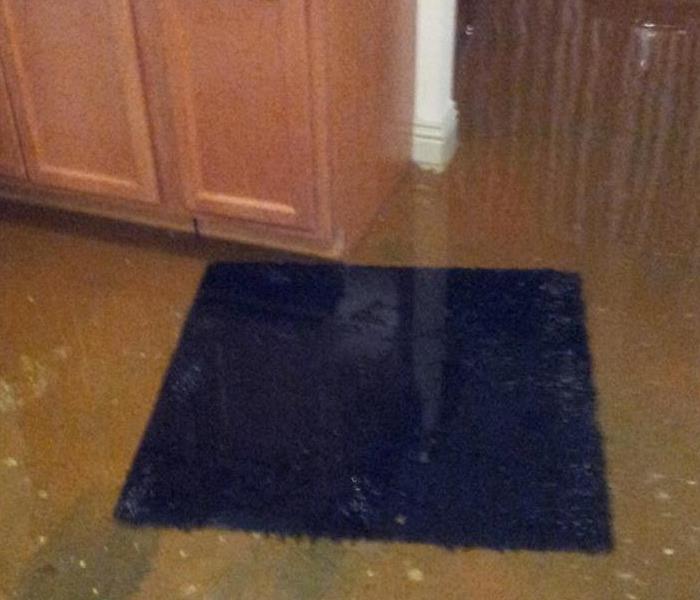 This flooded kitchen was caused by a torrential rainstorm
This flooded kitchen was caused by a torrential rainstorm
Storms can impact your Edmund home in several ways. Hurricanes or torrential rainstorms can cause flooding. Standing or rising water inside your Edmund home can cause significant damage. SERVPRO® of Edmund and Midwest City is the right restoration company to quickly remove the water, dry your home, and repair the flood damage.
When flood water enters your home, it can impact almost every surface. Drywall and wood can become swollen with water. Fabrics and upholstery may become stained and moldy. These are just a few of the ways that water can impact your home. All water damaged materials will need to be dried or removed before the repair work can begin. Some items may be salvaged, but others will need to be replaced. The best results will be from a restoration company that is focused on restoring the property to its preloss condition.
You want a certified restoration company to perform the repairs after a storm. Companies that are active with the Edmund Chamber of Commerce. Companies that are certified by the Institute of Inspection, Cleaning, and Restoration Certification. SERVPRO of Edmund and Midwest City is active in both of these organizations. Additionally, act quickly to schedule service.
When you contact a restoration company, ask about availability. The company ideally will offer around-the-clock service. You have a short amount of time to dry your home before the potential risk for mold. A timely response is imperative. In addition, inquire about the steps the company will take to follow through on the work. Ask about what the finished results look like. Finally, what is the expected time frame for the project. Flood damage repair can be significant, and the process may be lengthy.
SERVPRO of Edmund and Midwest City should be your first choice for any residential or commercial fire damage. Our team of professionals is trained to assess the damage, identify potential threats, and respond quickly to restore your property to preloss condition. SERVPRO of Edmund and Midwest City is available 24/7 by calling 405-330-2095
Yard Water Management
7/18/2023 (Permalink)
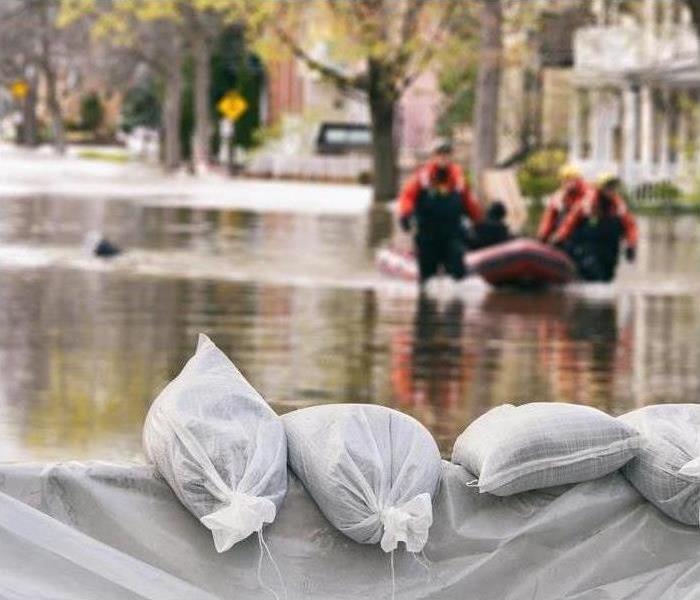 Many outside flooding issues can be resolved with minor alterations to existing lawn and garden practices.
Many outside flooding issues can be resolved with minor alterations to existing lawn and garden practices.
Weather conditions are widely variable in Edmond, OK. Discover how to control outside flooding and protect your property with a few simple landscaping practices.
1. Roof and Gutter Changes
One of the easiest fixes for excess water pooling around the home involves proper roof and gutter maintenance. If shingles are in disrepair or the gutters are clogged, this can prevent water from flowing cleanly off the roof and through the downspout during a rain storm. This means that rain can spill directly down near the house and seep into the foundation, basement, and crawlspace. In turn, this may require you to contact a flood cleanup service. Prevent this with proper roof inspections, yearly gutter cleanings, and downspout designs that deposit the water farther away from the base of the house.
2. Slope Control
Homes are typically built such that the soil slopes downward toward the border of the property, directing the water flow away from the home. If you notice outside flooding or any type of pooling, purchase additional topsoil or gravel to change the grade of your yard at that location by simply filling in the hole. If the water flow is excessive, it may be beneficial to dig a shallow drainage canal instead, bordered by slightly raised land on either side. These sloping variations are called swales, and can subtly solve rain drainage problems without disrupting the visual elements of your landscaping.
3. Surface Materials
Some ground cover materials are more suitable for wet conditions than others. If you have clay or silt soil, you may have noticed that running water tends to erode channels in your yard and prevent grass from growing in some locations. Plant sturdier shrubs and use heavy mulches or gravel to keep your topsoil layer from slowly washing down the storm drain.
Many outside flooding issues can be resolved with minor alterations to existing lawn and garden practices. Observe how water tends to flow through your property and make corresponding landscaping adjustments.
8 Ways to Stay Safe During a Tornado
6/23/2023 (Permalink)
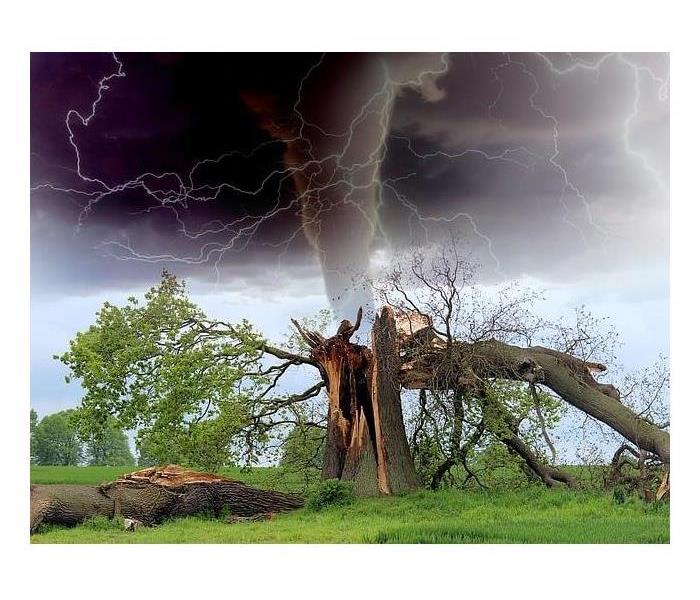 How you can stay safe in Oklahoma City during a tornado.
How you can stay safe in Oklahoma City during a tornado.
Tornadoes around the Oklahoma City area are powerful and unpredictable natural disasters that can cause widespread damage and endanger lives. When a tornado warning is issued, it's crucial to know how to protect yourself and your loved ones. Here's 8 essential tips and precautions to help you stay safe during a tornado.
Stay Informed: Monitor local weather reports and listen to emergency alerts. Many communities have sirens or warning systems in place to alert residents of approaching tornadoes. Sign up for emergency notifications on your mobile phone, as well as any local warning systems, to ensure you receive timely updates.
Designate a Safe Shelter: Identify a safe shelter in your home or community. Ideally, this should be a basement or storm cellar, as these areas offer the best protection. If you don't have access to a basement, choose an interior room on the lowest level, away from windows, such as a bathroom or a closet. Avoid upper floors and areas with large spans of glass.
Prepare an Emergency Kit: Assemble an emergency kit that includes essential supplies such as non-perishable food, water, flashlights, batteries, a first aid kit, a battery-powered radio, a whistle, and a portable charger for your electronic devices. Keep this kit easily accessible, so you can grab it quickly in case of an emergency.
Take Cover: When a tornado warning is issued, take cover immediately. Grab your emergency kit and seek shelter in your designated safe location. Protect your head with a helmet or sturdy object, and use pillows, mattresses, or heavy blankets to shield yourself from flying debris.
Stay Away from Windows: Windows are particularly vulnerable during a tornado. Avoid them at all costs, as they can shatter and pose a serious risk of injury from flying glass shards. Close curtains, blinds, or shades to help prevent shattered glass from scattering into your safe shelter.
Avoid Mobile Homes: If you live in a mobile home or temporary structure, it's crucial to evacuate to a sturdier building or designated tornado shelter. Mobile homes are highly susceptible to damage during tornadoes, and they do not provide adequate protection.
Stay Calm and Reassure Others: During a tornado, it's natural to feel scared or anxious, especially if you have children or vulnerable individuals with you. Stay calm and provide reassurance to others. Speak in a soothing tone and explain the safety precautions you have taken to alleviate their fears.
Do Not Venture Outside: Under no circumstances should you attempt to go outside or leave your safe shelter during a tornado. Wait until the authorities declare the area safe before venturing out. Tornadoes can quickly change direction and intensity, so it's essential to remain in a secure location until the danger has passed.
Storm Preparation
4/4/2023 (Permalink)
You should know well in advance when a storm is going to blow through Edmond, OK. While there is only so much you can do to prepare and protect your home, you should still take action to do everything possible to prevent flood water from entering your abode and water damage from harming your property, because a completely flooded building is the last thing you need to deal with.
1. Learn How to Shut Off Electrical and Water Supply
If you do not currently know where your circuit breaker and water main are located, then you need to find them on your property. You should turn off the power if your block experiences a power outage. You want to shut everything off because in the event power is restored, the sudden burst of energy could overload the system, resulting in significant damage to electrical appliances. You should also turn off all utilities right before you have to evacuate, if necessary.
2. Relocate Valuables
Keep any precious heirlooms out of the basement, which is most susceptible to flood water. You also want to keep valuables away from doors and windows, because they are entry points by which water or winds can enter.
3. Trim Trees
When you have several weeks’ notice of an oncoming storm in Edmond, OK you should consider hiring a professional service to trim and prune trees that are too close to your home. A diseased tree or weakened branches can break off and strike a building.
4. Move Lawn Accessories Outside
With strong enough winds, outdoor ornaments and furniture can become projectiles. Move them inside for the time being, or secure them outside by using a bungee cord or cable.
5. Maintain Gutters
Your home’s gutters help keep flood water away from the siding and foundation of your house. Remove leaves and other debris from them regularly so water does not become impeded.
3 Benefits of Storm Shutters
7/20/2022 (Permalink)
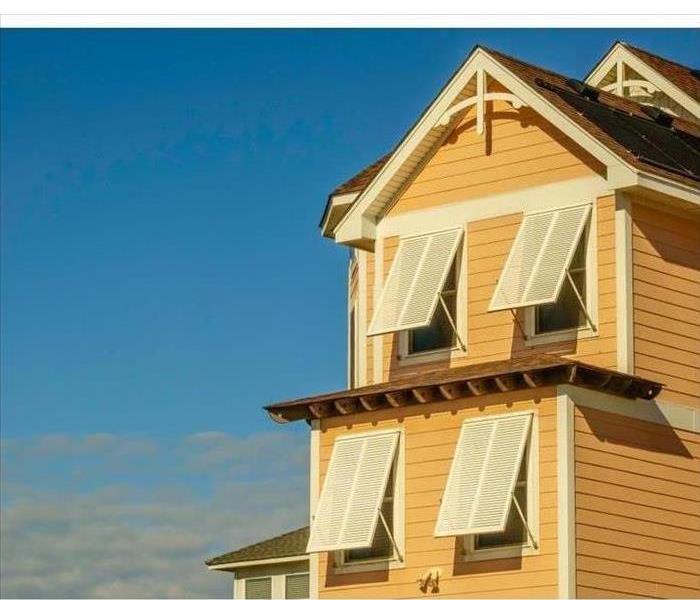 Storm shutters can help protect your windows during a severe storm
Storm shutters can help protect your windows during a severe storm
Reasons Why Storm Shutters Are Beneficial To You
Dealing with high winds in Oklahoma City, OK, can be a challenge. They can cause a great deal of damage, and while your storm damage experts can help you repair your home, there are some things you can do to help prevent some of these issues from occurring in the first place. One thing to consider is having storm shutters installed on your windows. There are several reasons why this may be beneficial to you.
Reduce Broken Windows
When you have shutters on your windows, you can reduce the risk of a broken window. Wind, snow, and hail can damage windows and could lead to entire windows needing to be replaced. This can cause several issues:
- Broken glass can cause lacerations.
- Windows can be expensive to replace.
- Energy efficiency can be drastically reduced when a window is broken.
Storm shutters can help protect your windows during a severe storm.
More Energy Efficient
A great deal of energy is lost through the windows during the cold and winter months. High winds can cause brutal wind chills, and this can lead to a rise in your utility bills. In the summer, the sun shining directly in your windows can heat up a room quickly. Shutters can help reduce the amount of heat or cold that comes into contact with your window, helping you save money on your energy bills.
Increase Home Value
It's a good idea to do whatever you can to raise the value of your home. Adding things like shutters to your home can help increase your home's value. This can be especially beneficial if you are considering putting your home on the market at some point in the future.
Adding storm shutters to your home can be a great investment. It may save you money in the long run on utility bills alone, and can also save you from the headache of expensive repairs from high winds during storms.
How To Use Landscaping To Limit Exterior Home Flooding
6/19/2022 (Permalink)
 A rain garden collects water during heavy downpours.
A rain garden collects water during heavy downpours.
How To Use Landscaping To Prevent Flooding Outside Your Home
Severe rainfall has increased throughout America in recent decades. Climate change likely will only make the problem worse. While rain storm restoration professionals can assist you after a weather disaster, you should also take steps to limit the inside and outside flooding of your property.
Exterior flooding can be particularly damaging. Luckily, you can reduce the effects of runoff and soil erosion by making a few simple changes to your landscape.
1. Plant a Rain Garden
A rain garden collects water during heavy downpours. The water then slowly absorbs back into the soil. Create your garden with native plants that require minimal maintenance. The edge of the garden typically drains the most quickly, so the center should be reserved for plants that can best handle wet soil.
2. Get a Downspout Diverter
Improper drainage is a common cause of outside flooding. A downspout diverter, however, can move water away from your property's walls.
3. Use Swales for Rain Drainage
A swale is a landscape depression that redirects the flow of water. However, swales do not actually stop the water. You thus need to make sure the water is directed to a safe location, such as a dry well. Do not have the swale drain right off your property, or you could face increased utility charges.
4. Utilize Heavy Mulch
A rainstorm can easily displace light mulch chips. These chips can then clog drains and make flood cleanup more difficult. Opt instead for heavier, hardwood mulches that remain in place during severe weather events.
5. Go Green
Green roofs are becoming common and affordable. Besides reducing stormwater runoff, they also improve the insulation of homes. This could save you money on your cooling and heating bills.
Outside flooding can destroy the gorgeous backyard of your Edmond, OK, home. You cannot prevent the severe rainstorms that bring this excess water. However, you can and should adjust your landscape to limit the effects of these storms.
Include These Elements in Your Building's Storm Preparedness
4/25/2022 (Permalink)
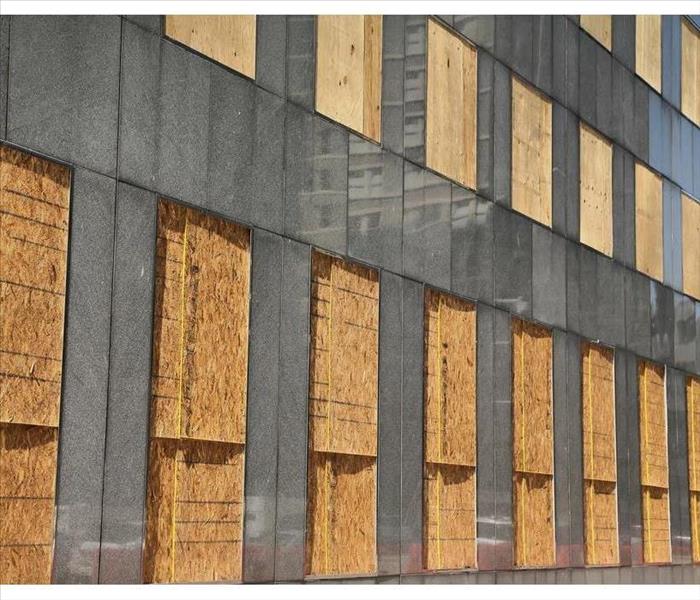 Protect the exterior of your building by boarding them up.
Protect the exterior of your building by boarding them up.
Commercial Building's Storm Preparedness
Exterior maintenance is an important part of your commercial building's storm preparedness plan alongside proper staff procedures and medical kits. Having the building maintained up to standards can help it withstand the power of Oklahoma City, OK, storms and minimize damage. Before such event takes place, ensure that the building includes the following elements and practices.
Unblocked and Clear Drainage
A business building inspection should include a well-maintained drain system from the roof to below. It should consist of elements such as:
- Drains
- Gutters
- Downspouts
- Roof slopes
These elements work together to take rainwater from the building's roof to the ground. If the water accumulates on top, it can either seep through the cracks and damage your property or cause the roof to break completely, leaving the area vulnerable. You should also ensure the drain system is in great condition. Remove any blockage and fix any existing damage.
Secured or Removed Loose Accessories
As part of your exterior maintenance, you should also consider any separate items that are around the building that serve your business. Some of these objects include tables, chairs, trash cans and signs. A powerful storm can move them around and crash them against your location or other people's properties. Ensure you have enough room to take the items inside. If you have larger structures like trailers, dumpsters and portable restrooms, you can anchor them to the ground or to fixtures using rope or chains.
Shuttered or Boarded-Up Glass
Glass surfaces such as windows, skylights and glass doors are vulnerable to the impact of high winds and debris. Their destruction creates further water damage and even endangers staff. Make sure there are exterior shutters and covers ready to protect these items from the elements. If the storm is coming soon and you lack shutters, board up these surfaces to reduce the damage.
Professional storm damage restoration can always help bring your establishment back to normal. However, with proper exterior maintenance, you can mitigate the negative effects.
3 Frequently Asked Questions About Flood Insurance
4/6/2022 (Permalink)
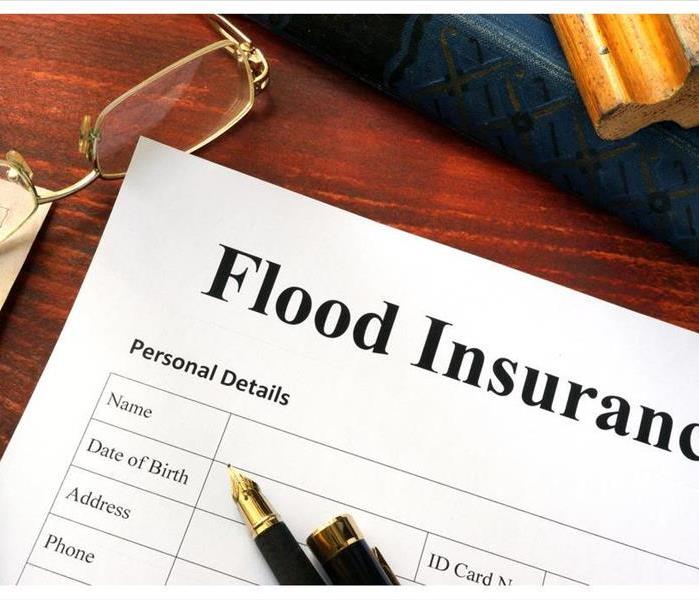 Flood insurance is essential for any business owner.
Flood insurance is essential for any business owner.
Questions About Flood Insurance
One storm can have a devastating impact on your business. Your commercial property insurance policy covers damage caused by many natural disasters, including wind and lightning. However, floods following heavy rain are not typically included in these policies. To protect your company, you should thus purchase separate flood insurance.
In fact, a flood policy is mandatory for some business owners. If you purchased a mortgage from an insured or federally regulated lender, and your property's location is at a high risk of flooding, you must purchase flood coverage. Still, even if you are not legally required to buy a flood policy, the benefits of this insurance outweigh the downsides. Below are the answers to three common questions about this type of insurance.
1. What Does This Insurance Cover?
Flood coverage includes both your building and the contents inside it. A typical policy does not cover items outside your structure, including company cars and septic systems.
2. How Do You Get This Insurance?
Most commercial insurance companies do not offer flood coverage. However, you can purchase a flood policy through the National Flood Insurance Program.
You do not contact the government to get this insurance. Instead, find an insurance agent in Arcadia, OK, who can help you purchase flood coverage from the NFIP. Once you buy the policy, it usually takes one month to go into effect.
3. How Much Insurance Coverage Do You Get?
A commercial flood policy usually includes $500,000 of coverage for the contents of a building and another $500,000 for the structure. This should help you pay for water damage restoration services. If you think this amount is not sufficient, you can always purchase excess coverage.
Flood insurance is essential for any business owner. It should help you pay for repairs to your property after a storm. This way, you do not have to spend your company's hard-earned profits on restoration services.
Ice Dams and How They Can Affect You
1/11/2022 (Permalink)
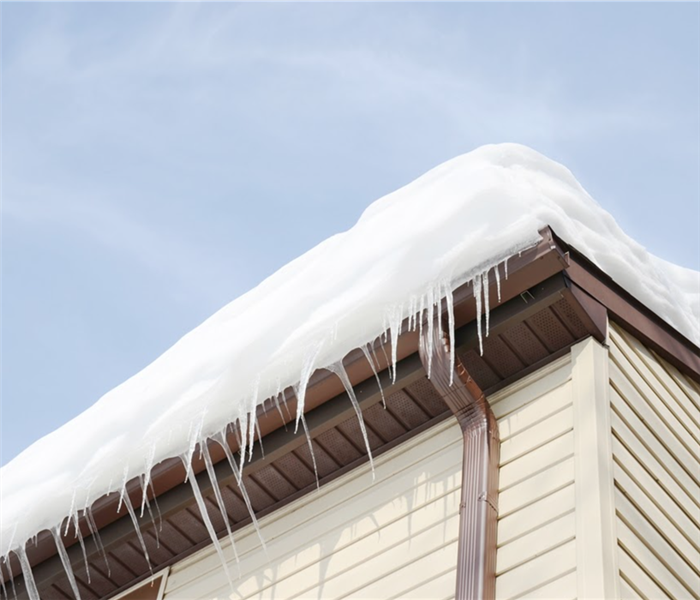 If snow and low temperatures affect your roof, you might be dealing with an ice dam.
If snow and low temperatures affect your roof, you might be dealing with an ice dam.
What Are Ice Dams and How Do They Affect You?
The winter can bring many new challenges and situations to a home. If snow and low temperatures affect your roof, you might be dealing with an ice dam. These snowy ridges can block gutters and cause water damage in your home, but there are many solutions that you can use to prevent that from happening.
How It Forms
An ice dam always begins with snow. As it settles on to your roof in Edmond, OK, it freezes when the temperature goes down. However, as the sun comes out during the day and heat from your house escapes through the shingles, things get complicated. The snow melts but hits a ridge of ice and escapes through your roof into your home.
How To Prevent It
It’s always a good idea to start preventing an ice dam before a winter storm settles in. The best way to prevent ice dams is to insulate your roof and prevent heat loss. Here are a few ways you can do this:
- Vent the space between the shingles and insulation to direct the heat away from the roof
- Seal any air leaks
- Insulate more to prevent conduction of heat through the ceiling
By preventing heat loss, you can prevent ice ridges from forming and save money on heating.
How To Deal With It
If you already have a situation where a ridge of ice is forming and snow is melting, there are a few things you can do right now to prevent water damage. You can start by scraping snow off the roof to prevent further problems. The second solution is to create passageways in the ice to allow the water to escape safely.
If water has already affected your home, be sure to call restoration professionals before mold forms or the damage gets worse. Ice dam coverage can vary, but it doesn’t hurt to call your insurance either. With these solutions and preventative measures, you can stop an ice dam from interfering with your roof and home.
Flood Prevention Strategies for Communities
11/15/2021 (Permalink)
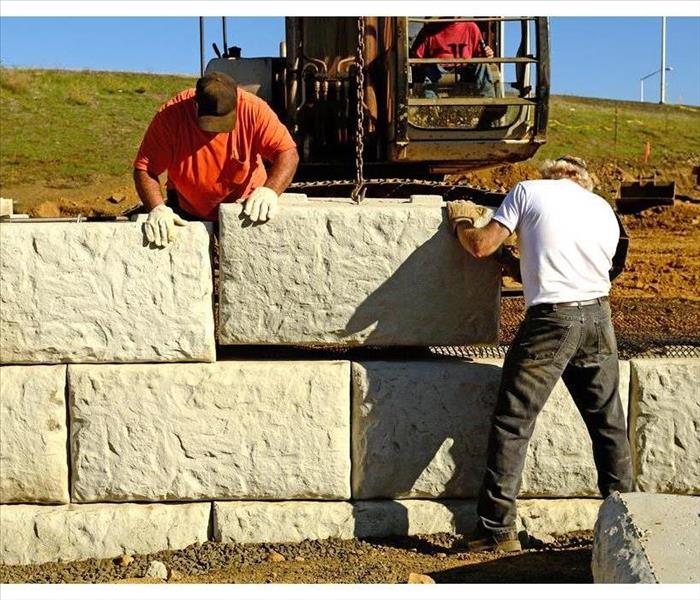 Retaining walls may be constructed to provide temporary holding spots for water.
Retaining walls may be constructed to provide temporary holding spots for water.
Flood Prevention Strategies
Whenever heavy rain storms roll into Oklahoma City, OK, one after another, or hurricane season hits the coasts, flooding and safety become pertinent topics. Whether you're concerned about your business or the safety of your employees, you're probably invested in municipal flood prevention strategies. There are five common approaches that could be implemented in your area.
1. Detention Basins
These sunken zones are often connected to, or located near, waterways. They serve as temporary reservoirs for rising levels of water. A park, for example, may have a sunken layer, shaped to hold water in a makeshift pond until water levels decrease. This gives people in your community more time to make necessary arrangements for getting to safety.
2. Landscaping Elements
Erosion adds new levels of damage to those caused by water. The rushing water often washes away natural barriers and foundations. Strategic placement of trees, shrubs, and grasses may prevent harmful erosion. This tactic may also reduce the debris that gets washed downstream, reducing some of the damage left in the aftermath of the rushing water and adding to flood prevention.
3. Retaining Walls
If flooding is a consistent problem in the community, retaining walls may be constructed to provide temporary holding spots for water to accumulate during high water times. These temporary dams or retention ponds can provide extra time for communities to evacuate.
4. Defense Walls
The defense walls are put in place to deter tidal waves from threatening buildings and structures in town. During severe weather, sand bags may provide an additional support to the walls.
5. Human Efforts
No matter how well town developers plan for potential flooding, if community members allow drainage systems to become clogged with trash and vegetation, prevention strategies will be useless. Waterways, gutters, and drainage areas must be kept clean and free of litter.
With the common goal of flood prevention, city planners, business leaders, and community members can all make an effort to prepare for storms. A united effort can decrease the need for flood cleaning, prevent significant damage, and possibly save lives.
3 Reasons You Should Never Drive Through Floodwaters
9/20/2021 (Permalink)
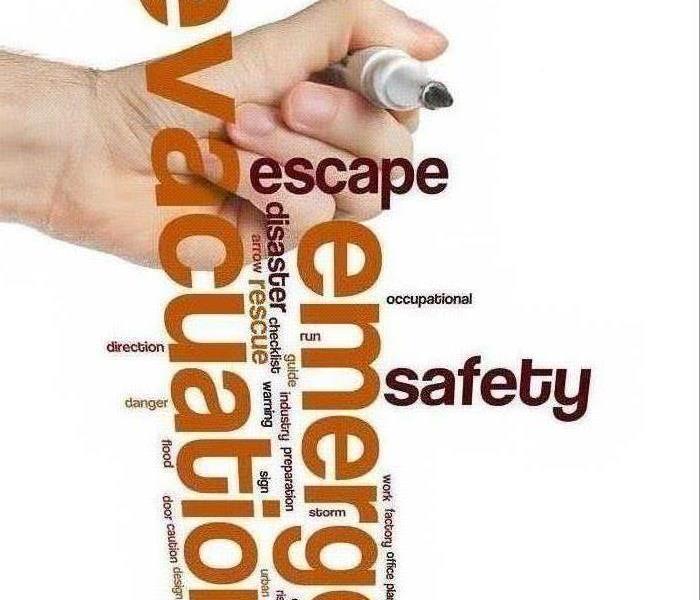 Compared with the reasons not to drive on a flooded street, the reasons that tempt you are faulty.
Compared with the reasons not to drive on a flooded street, the reasons that tempt you are faulty.
There are many reasons someone might try to drive through the deep, standing waters of a flooded street. Perhaps they are trying to pick up their children from school. Maybe they're trying to get home to see what sort of havoc the storm is wreaking there. No matter how good the reasons to drive through flooded roads in Oklahoma City may seem, however, the reasons not to drive through floodwaters outweigh them.
Lack of Vision
Deep waters obscure your view of the actual street. If you can't see the pavement, you don't know what you're driving into. There could be any number of hazards below the surface:
• Fallen branches from damaged nearby trees
• Signs or other items that have washed into the street
• Sinkholes where the water has weakened the pavement
Don't risk getting hurt or stuck by something you cannot see.
Damage to Car
Your car is not amphibious. It is an electrical machine, and water and electricity don't mix. It wasn't made to go through water deeper than a couple of inches, and even that is pushing it. On a flooded street, your car may stall or die completely if too much water gets into certain parts of the car.
Danger to You
Floodwater tends to move rapidly and take everything in its path with it. This includes your car and, by proxy, you. Fast-moving water can flip your car, not only causing more damage to the vehicle but also putting your life in danger. Avoiding flooded roads may mean avoiding potentially serious injuries.
Compared with the reasons not to drive on a flooded street, the reasons that tempt you are faulty. Your children are probably safer at the school than they would be in your car, and water mitigation specialists can fix whatever is happening to your home. Follow these travel tips and only drive where you can see the road.
What to Expect With Storm Damage Cleanup
7/29/2021 (Permalink)
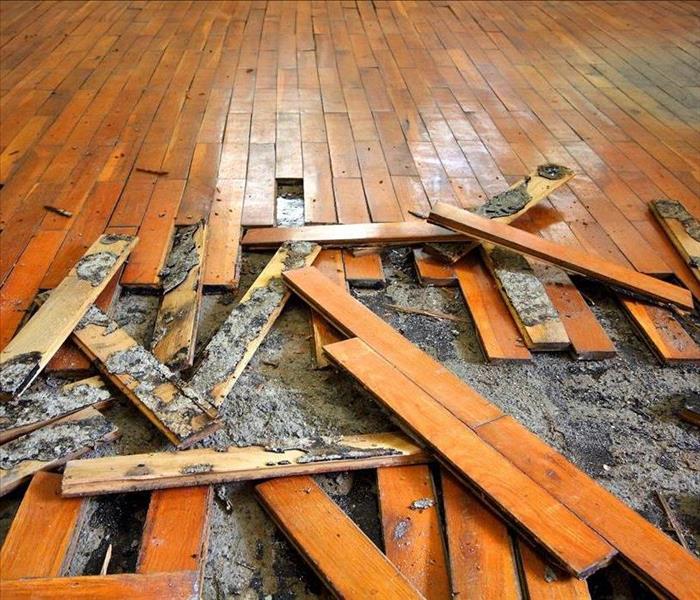 When water infiltrates your home it can cause damage to your floor.
When water infiltrates your home it can cause damage to your floor.
What to Expect When Cleaning Up After a Storm
No matter where you live in Oklahoma Christian University, OK, you’re bound to get some serious storms every now and then. Usually, these storms won’t cause many problems, but the worst incidents can damage parts of your home and property. If you have water damage or other issues following a storm, you need to quickly tear out affected items. There are other steps to ensure a successful cleanup, so make sure you know what to do.
Assessment
Your best bet following a significant storm is to call an experienced cleanup or storm restoration company to evaluate your needs. A company representative will do some of the following:
- Walk through the home and make note of damages
- Assess what steps to take next
- Evaluate whether cleanup or complete replacement is necessary.
Remove the Water
A technician’s first task will be to extract any remaining water in your home. The specialist will use a wet vacuum or other professional-grade machines to suck up the water. Then, the team will dry the area using high-powered fans.
Remove Ruined Items or Portions of Your Home
When water infiltrates your home, it can cause widespread damage, especially to furniture, walls and flooring. Unfortunately, it is sometimes impossible to salvage carpet, hardwood or flooring. If this is the case at your Oklahoma Christian University, OK, home, the professionals will tear out the affected areas. This will create a safe environment for you and your family and will help ward off mold growth.
Restoration
If you and the professionals can’t salvage parts of your home, the company will work on restoring those areas. These will usually include flooring, walls and parts of your roof. This process will help ensure you can once again live in your home without suffering adverse effects or dealing with safety issues.
It’s important to tear out ruined items after a flood or other damage. You also need an expert to handle other aspects of the cleanup process.
4 Commercial Roof Maintenance Tips
5/26/2021 (Permalink)
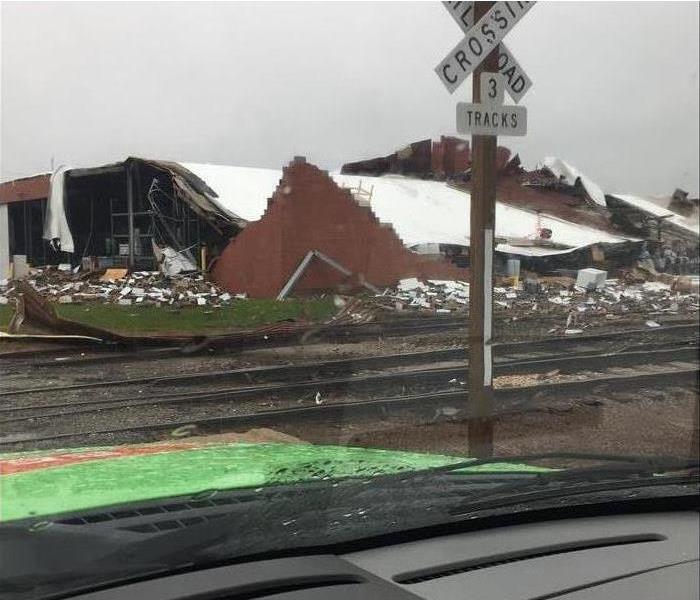 Storm damage to commercial property in Hibsaw, OK.
Storm damage to commercial property in Hibsaw, OK.
Commercial Roof Maintenance Tips
The roof is one of the most important parts of any building. A roof leak can lead to water damage and mold growth. Consider adding these four maintenance tips to your roof maintenance plan to avoid problems with your roof.
1. Have Regular Inspections Done
Schedule a professional roof inspection at least once per year. Inspectors can look for wind damage, leaks or sagging areas so that they can be addressed before they get worse. It is also a good idea to have your roof inspected after a weather event, such as hail or high winds, that could have caused damage. However, avoid walking on the roof yourself. This can lead to roof damage.
2. Repair Leaks Immediately
You should call a professional in Hibsaw, OK, to repair a roof leak as soon as you become aware of it. If you put repairs off, the ongoing leak could lead to damage to inventory and equipment, electrical damage, a roof collapse or a need for extensive water restoration efforts. The earlier you have repairs done, the less you are likely to pay in repair costs.
3. Keep Your Roof Clean
Debris on your roof can contribute to poor drainage. This may result in standing water that could promote algae growth and lead to deterioration. Periodically clean debris, such as tree limbs and leaves, off your roof and AC units.
4. Clear Snow in the Winter
The weight of accumulated snow on your roof can cause damage or even lead to a roof collapse. It may also contribute to ice dams forming that can lead to leaks. Make removing snow from your roof a regular part of your snow removal plan.
Regular maintenance can help extend the life of your roof and avoid problems, such as a roof leak. The time and money you invest in maintaining your roof now will pay dividends down the road.
5 Critical Questions To Ask When Creating a Continuity Plan
4/10/2021 (Permalink)
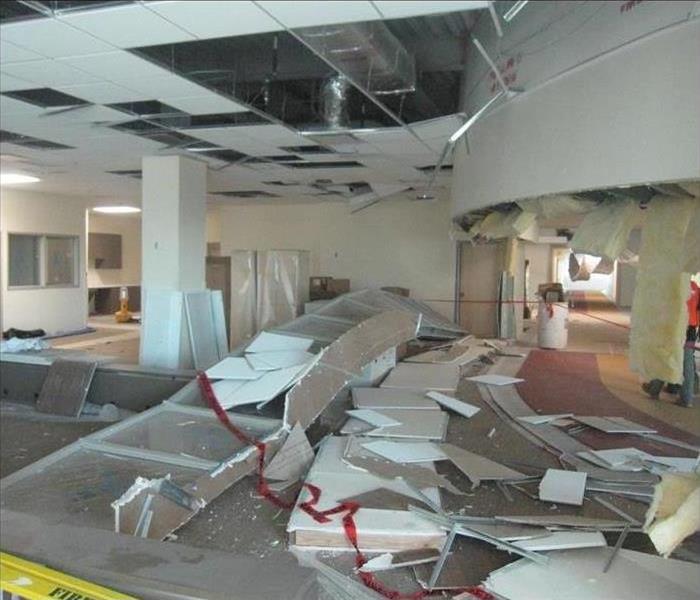 Commercial severe storm damage.
Commercial severe storm damage.
Five Critical Questions
When storms threaten to wreak havoc in Oklahoma Christian University, OK, there is often only a short window of time to make important decisions and prepare your property, personnel and operations for a significant disruption. If the situation is severe, you may even need to evacuate the area. That's why you need to develop and practice a business continuity plan before disaster strikes. To begin, address these five critical questions.
Who?
Perhaps the most important thing to establish first is the chain of command:
- Who makes the critical in-the-moment decisions?
- Who will be in charge if you are not available?
- Who are your team leaders in an emergency?
- Who will report incidents and assess any storm damage?
- Who are the clients and vendors that need to be contacted right away?
- Who will you contact if there is a need for flooding cleanup and restoration?
What?
What will be your strategies to mitigate loss and recover functionality after an interruption? Your continuity plan should include an analysis of your business's most important functions, how much downtime is acceptable and what specific areas are vulnerable in an emergency.
When?
You'll also need to determine at what point you will evacuate and move your operations elsewhere. Will you leave preemptively, or will you wait until directed by local officials? Also, at what point will you know you can return or resume normal business operations?
Where?
Where will you go if you need to relocate temporarily or for a longer period of time? Where will your equipment be stored if you wait to resume operations until your permanent location is ready? Will working remotely from home be an option until things get back to normal?
How?
Once you have the basic questions answered, outline the specific steps you will take from beginning to end. Like fire drills, your continuity plan should be practiced regularly and updated as your situation changes. Everyone should feel confident that they know what to do when the time comes.
Fortunately, most storms give you some lead time to move your plan into action, but not all-natural disasters can be forecasted. Having a thorough and practiced plan in place will help your business survive and bounce back sooner when emergencies happen.
How To Minimize Storm-Related Roof Damage
1/14/2021 (Permalink)
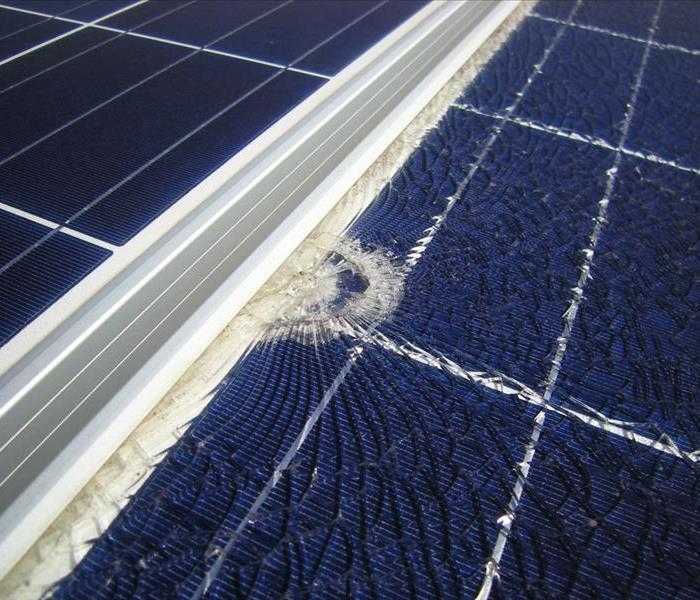 A solar panel can suffer many forms of damage
A solar panel can suffer many forms of damage
Whether you have solar paneling or a more traditional roof, a strong storm can do major damage. There are many types of storm damage, including panel damage, that could befall the roof of your Hibsaw, OK, home.
Damage to Solar Panels
Solar roofing is available in both panel and shingle form. Both styles are durable, but they can suffer many forms of damage, including
- Dents
- Scratches
- Breaks
- Sealant degradation
Panel damage can affect the roof’s energy output. For example, scratches decrease the amount of sunlight the panel can absorb for conversion. Keeping your solar roof clean will minimize scratches. If one area of a panel is damaged, then the entire panel may be affected. Installing smaller panels makes this issue less problematic.
Damage to Traditional Roof Styles
Asphalt shingles and metal roofs are more common than solar roofing. Fortunately, when properly installed and maintained, they should hold up well to most weather events. Strong storms, however, can cause the following types of roof damage:
- Broken shingles
- Missing shingles
- Broken or misshapen flashing
- Punctured metal roofing
After a heavy storm, inspect your roof yourself or hire a professional to inspect it. Take care of any problems as soon as possible to prevent further damage. If the damage led to a leak, stop the leak and dry up the water within 24 hours to prevent mold growth. An experienced restoration team can help you with the water damage restoration process if necessary.
As with solar roofing, routine maintenance is key. Storms often exacerbate weak spots, so it is important to perform regular inspections to catch problems early.
After a storm, your roof may have solar panel damage, missing asphalt shingles or any number of other problems. Routine maintenance can keep your roof in good shape to weather storms, and an inspection afterward enables you to repair any damage before it becomes a serious problem.
3 Methods To Prevent Flooding
11/16/2020 (Permalink)
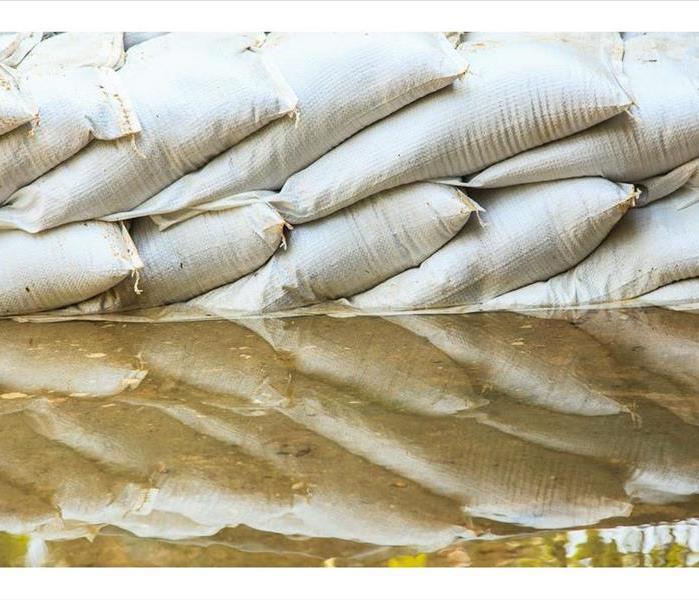 Sandbags are an inexpensive and low-tech way to stop flooding
Sandbags are an inexpensive and low-tech way to stop flooding
Methods To Block The Flow Of Water
High water can creep over levies, bridges, beaches, and river banks. In extreme situations, floodwater can cripple entire towns. Luckily, cities have many options to choose from to protect inhabitants from floods. The costs associated with flood prevention are often justified because flood water can cause a significant amount of damage to a city. In a worst case scenario, people can be evacuated or left without power for weeks or months. Here are three methods cities are using to block the flow of water.
1. Sandbags
Sandbags are an inexpensive and low-tech way to stop flooding. Although the bags of sand are heavy and can be difficult to maneuver, they can be set up when needed and in minimal time. Sandbags may be appropriate for drier areas that are rarely threatened by floodwaters. Sandbags can be stacked on top of each other, but are not appropriate for high waves that can crash over the top of the sandbags.
2. Oosterscheldekering
Around a third of Holland sits below sea level. To keep the city safe from high water, engineers designed a unique solution. The Oosterscheldekering appears similar to a traditional dam but consists of moveable gates that are used to easily control the level of water.
3. Hagestein Weir
A moveable weir is located near the village of Hagestein in the Netherlands. The Hagestein Weir is not only used to stop flooding, but is also used to generate clean power. Two enormous arched gates that together span 54 meters can be lowered to stop the flow of water or raised to let the water pass through. Rhode Island used a similar system after Hurricane Sandy.
High water can leave a path of devastation in its path. As a business owner in Edmond, OK, you want to find the best location for your business, which includes protection against floodwaters. If you find yourself with damage after a flood, call a professional water remediation company to help restore your business to its pre-flood condition.
4 FAQs About Disaster Assistance
10/21/2020 (Permalink)
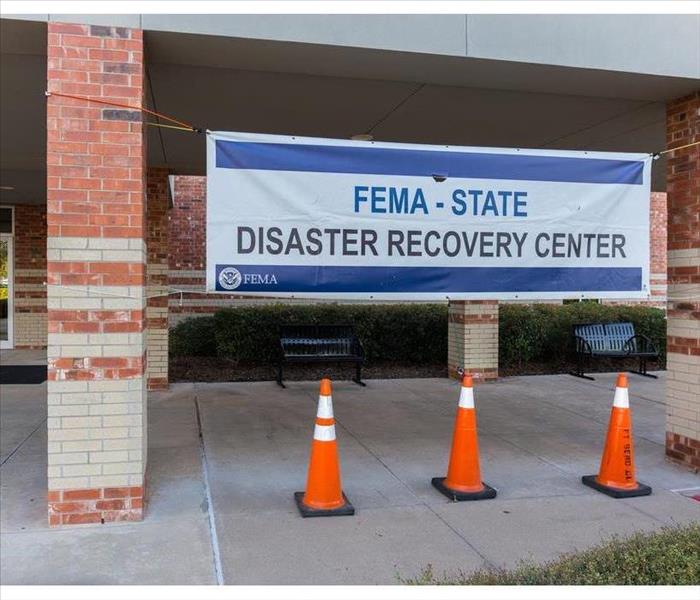 You may be eligible for disaster assistance from FEMA
You may be eligible for disaster assistance from FEMA
4 FAQs About Disaster Assistance
If you have recently experienced a natural disaster, such as a flood, you may be considering applying for disaster assistance. The best way to make this decision is to know the answers to some of the most frequently asked questions about disaster assistance.
1. Will FEMA Rebuild My Home?
The Individuals and Households Program by FEMA provides funds for any expenses that are underinsured or uninsured. However, this program is not a substitute for insurance and does not cover all costs you may face. It is designed to get you back on your feet after a disaster and help you meet basic needs. It is not guaranteed that your house in Hibsaw, OK will be rebuilt entirely through this program.
2. Who Should Apply for Assistance?
Any homeowners, renters, and business owners who had damage to their vehicles, property, or business as a result of a disaster should apply. However, the property must be in a county that has been presidentially declared a disaster area. Disaster assistance can help you repair, rebuild, or replace some damage.
3. What Assistance Is Available?
Disaster assistance may cover temporary housing, home repairs, property loss, and other expenses. Also, there are low-interest loans available for business owners, homeowners, and renters. These funds are designed to cover uninsured and underinsured costs, not pay for something that is covered under your insurance policy.
4. Are You Eligible for Assistance if You Have Insurance?
Your insurance should be your primary source of funds after a disaster. You need to contact your insurance company if you experience damage. It would be best if you did this as soon as possible.
However, insurance may not cover some of the expenses caused by a disaster. Therefore, even if you have insurance, you should still apply for disaster assistance through FEMA.
If you have recently experienced a disaster, such as flooding, you may be eligible for disaster assistance from FEMA. They can give you the funds you need to hire storm damage restoration professionals and get your life back on track.
Water, Water Everywhere
9/24/2020 (Permalink)
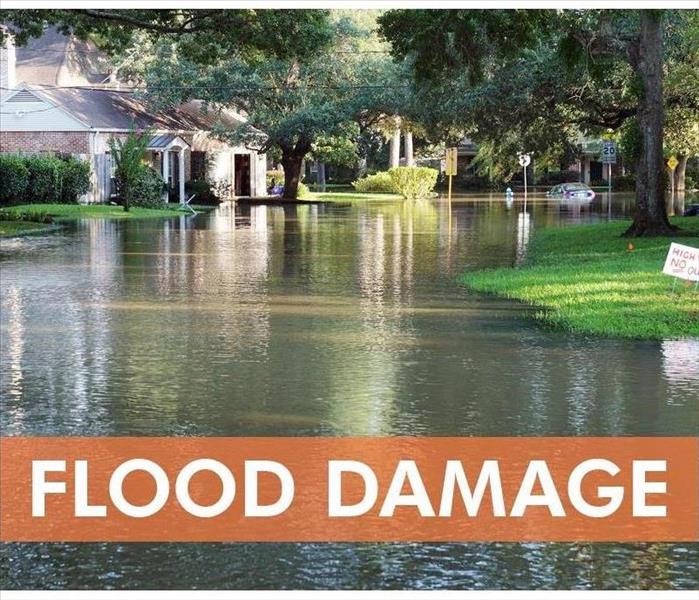 Floodwaters are powerful, unpredictable, and dangerous.
Floodwaters are powerful, unpredictable, and dangerous.
Drivers and pedestrians in Edmond, OK, take a life-threatening risk when choosing to navigate a flooded street, especially in weather with heavy rain and driving winds. The National Weather Service strongly urges people to stay off flooded roads and to avoid flood-prone areas. The reasons are sobering.
Just 6 inches of rushing water can knock adults off their feet. A foot of moving water can wash away a small vehicle, and 2 feet can wash away most cars — even SUVs. It takes only a foot of water to float many vehicles, and once your car floats, you are powerless, at the mercy of rampaging floodwater. Here are a few travel tips and at-home guidelines to stay water-safe:
On The Road - When driving, closely monitor extreme weather conditions:
1. Avoid flooded areas, especially during stormy weather — rising water can gush into your vehicle in minutes, even seconds.
2.Remember that just 6 inches of water can cause a loss of control or stalling.
Never drive on a flooded street — it may be deeply cratered or washed out, and manhole covers may be missing.
3. Don't try to drive across fast-flowing streams that can swell rapidly and engulf your car.
If floodwaters overwhelm your vehicle, call emergency services. If safe, abandon it and try to reach higher ground.
At-Home Safety - Take precautions if your home is subject to the hazards of flooding:
1. Bring outdoor items inside or tie them down.
2. Drink only clean, safe water. Do not drink or use floodwater.
3. Dispose of food contaminated by disease-spreading floodwaters.
4. As a general rule, throw out all water-affected items.
5. After waters recede, thoroughly clean your home. Consider bringing in the services of water damage experts.
Floodwaters are powerful, unpredictable, and dangerous. Whether driving or walking, a flooded street should always be a no-go zone. At home, lower your health and expense risks by having a comprehensive flood plan at the ready.
The Coverage You'll Get From Commercial Storm Insurance
9/14/2020 (Permalink)
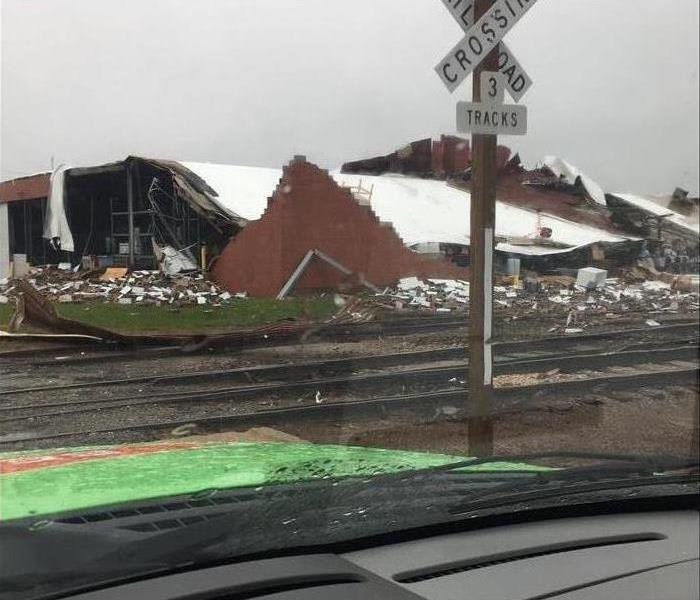 Storm damage to commercial property in Luther, OK
Storm damage to commercial property in Luther, OK
When you own a commercial building, the last thing you want is a disaster to strike and cause damage to the facility. This could lead to costly repairs and restoration. It could also hamper your business and keep the building unoccupied for the long term. Storm damage can wreak havoc, resulting in flooding and structural damage. If you purchase storm insurance, you can get the financial support you need during a difficult time. This coverage can also protect your valuable assets.
What the Insurance Won't Cover
It's first important to understand what your regular policy won't cover. For these issues, you'll need to buy supplemental coverage. Such events include the following:
- Earthquakes
- Flooding from sewer backups
- Flooding from a main water line burst
Hail Damage
Your commercial insurance coverage will pay on your claim for damage your building suffers during a hailstorm. This may include broken windows and siding, roof leaks, ruined personal items, or other related problems. If you live in an area in Luther, OK, where hail is common, you may need to rely on this insurance. This coverage applies to damage that occurs to the interior or exterior of the building.
Tornadoes
In certain parts of the country, a tornado can rage across the land, destroying everything in its path. Your commercial building could be a victim of this devastation. Luckily, storm insurance will pay for the damage your building suffers in such an event. This would include rebuilding and restoring the structure and replacing equipment and supplies inside.
Wind Damage
It doesn't take a tornado to harm your facility. High winds can cause severe problems with your roof or even knock over trees onto the structure. Your storm coverage should take care of any issues resulting from a windstorm.
Along with calling a storm cleanup company, you should notify your storm insurance agent if an unfortunate event occurs in your building. Insurance coverage can give you peace of mind.
4 Steps to Prevent Mold After a Home Flood
8/13/2020 (Permalink)
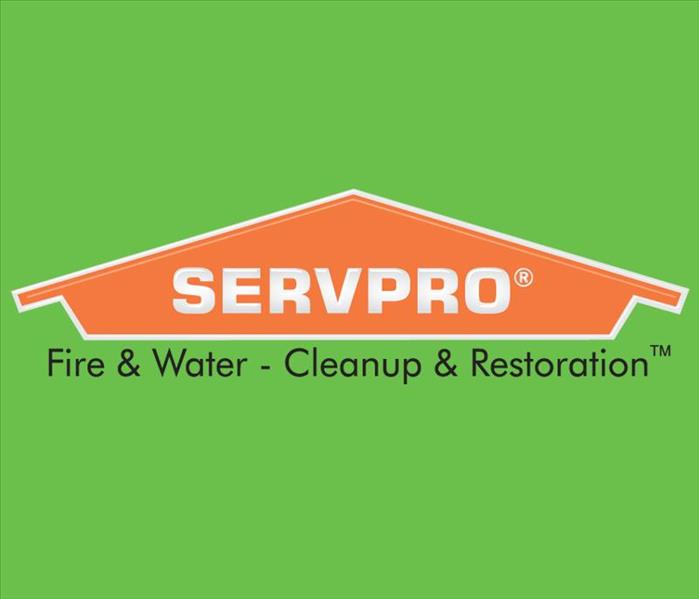 If your Edmond, OK, home is a victim of flooding, it’s susceptible to serious mold growth and damage.
If your Edmond, OK, home is a victim of flooding, it’s susceptible to serious mold growth and damage.
Whether your home floods due to a hurricane or a burst pipe, the water will do a lot of damage in a very short time. Every second will mean more damage, so it’s crucial to remove as much water as possible as quickly as possible. Mold growth can begin within 24 hours of exposure to water, so in addition to standing water, all excess moisture in the area needs to be thoroughly dried. Take these steps to prevent mold after a home flood:
1. Circulate the Air
If it’s less humid outside than inside, open doors and windows to allow for better airflow throughout the affected area. Everything needs to dry as soon as possible.
2. Remove Unsalvageable Items
Remove anything that isn’t salvageable. Most porous materials, unfortunately, will probably have to be disposed of. Carpeting usually can’t be dried fast enough to save it since mold can begin growing within 24 hours of water exposure.
3. Clean and Sanitize
Everything that’s salvageable needs to be thoroughly dried, cleaned, and then, disinfected. Borax tends to be a good cleaner for mold removal from most surfaces. It’ll also prevent mold growth. Porous materials like drywall will probably be beyond reclamation.
4. Dry the Area
The area and contents need to be dried as quickly as possible. Industrial fans and dehumidifiers will probably be needed if things are still soaked. The relative humidity should be below 50% to keep mold from growing. Until the excessive moisture is gone, mold will still grow. Although some materials like plaster may be able to be dried thoroughly within a few days, it may be better to tear out and replace since mold is likely to begin growing within that time.
If your Edmond, OK, home is a victim of flooding, it’s susceptible to serious mold growth and damage. You can count on water damage cleanup experts to return it to its preloss condition as quickly as possible.
How Is Cleaning After a Flood Different Than Cleaning Other Water Damage?
8/11/2020 (Permalink)
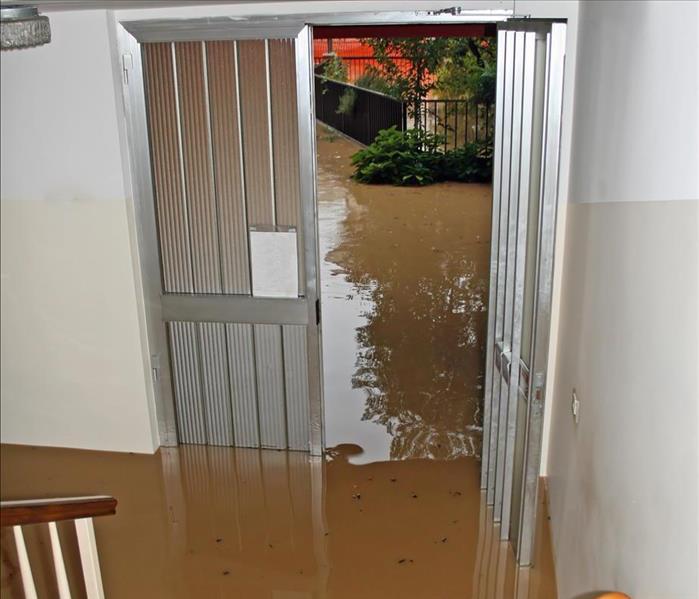 Flood damage in Waterloo, OK
Flood damage in Waterloo, OK
How Is Cleaning After a Flood Different Than Cleaning Other Water Damage?
You may think all water damage is all the same, but it’s not that simple. How you clean up after flooding depends on where the flood water comes from. The Institute of Inspection, Cleaning and Restoration Certification created three categories of water damage based on contamination level. What you can save or restore will depend on the water category.
Category 1 Water
Also called “clean water,” Category 1 water comes from a sanitary source and doesn’t pose any health risks. This kind of damage typically comes from:
- Broken water pipes and supply lines
- Malfunctioning appliances
- Flooding from rain and melting snow
You can usually dry items damaged by clean water and reuse them with no health risks.
Category 2 Water
This is called gray water, which means there’s serious contamination. Category 2 water can lead to health problems if you come into contact with it or ingest it. It comes from items such as toilets, washing machines, and sump pumps. Be cautious with materials that have flood damage from gray water. Thoroughly clean and disinfect them before putting them back into your home.
Category 3 Water
Category 3 water damage is also known as black water damage. It’s the most dangerous because it’s extremely contaminated, possibly with toxins. Category 3 water often occurs during hurricanes and severe rainstorms. Sources include sewage, rising waters and seawater. You’ll have to get rid of soft surfaces (such as carpets and window coverings) and structural elements (such as drywall and sheetrock).
If Category 2 water remains stagnant for too long or isn’t cleaned up properly, it can be reclassified as Category 3. You’ll want to start the restoration process as soon as possible to avoid future problems from mold and mildew.
If your home has damage from flooding, work with a water damage specialist who can clean up and dry out your home in Waterloo, OK, with the appropriate equipment and techniques. They’re trained to meet federal standards for cleaning and sanitizing your home.
How Cities Take Steps To Prevent Flooding
7/8/2020 (Permalink)
How Cities Take Steps To Prevent Flooding
Homes and businesses are not the only ones that are vulnerable to the ever-increasing cycle of flooding from storms seen in the past several years. Cities have also become the victim of flooding roads, torrential rains causing floods, and even broken dams or levees. Although most cities were not aware of the potential for floodwater disasters when they were built, urban planners have now begun using a variety of government supported methods to help manage the levels of high water.
Controlling the Water
One of the simplest methods of floodwater retention or prevention is the use of obstacles to control the flow of rising water and stop flooding. This is often done using:
Inland cities favor dams and barriers, while tide gates are preferred near coastal areas or in estuaries.
Diverting the Water
When cities are frequently hit by high water or heavy storm causing floods, city engineers often opt for channels to control runoff waters and help with flood prevention. These can be temporary holding ponds, man-made canals, or cement causeways. Using the waterways and conduits to safely remove dangerous water flow to safe holding areas can prevent both streets and businesses from flooding.
Saving the Water
Using the stormwater diversion methods above to collect much needed groundwater is a management method that many environmentally-conscious towns and cities have begun implementing. Building floodplain projects can help collect floodwaters and slow the runoff by allowing the liquid to seep into and restore the ecosystem. Rain gardens are also being built to slow the flow of water and move it into the soil.
Urban and city planners across the globe have discovered that flood prevention is often possible if steps are taken to deter the high water from collecting or running down a path that will cause great financial damage. To find out how you can prevent flooding around or within your business, contact a water remediation specialist or your Edmond, OK, city planning department.
Why Does Flood Damage Require Extra Cleanup?
4/28/2020 (Permalink)
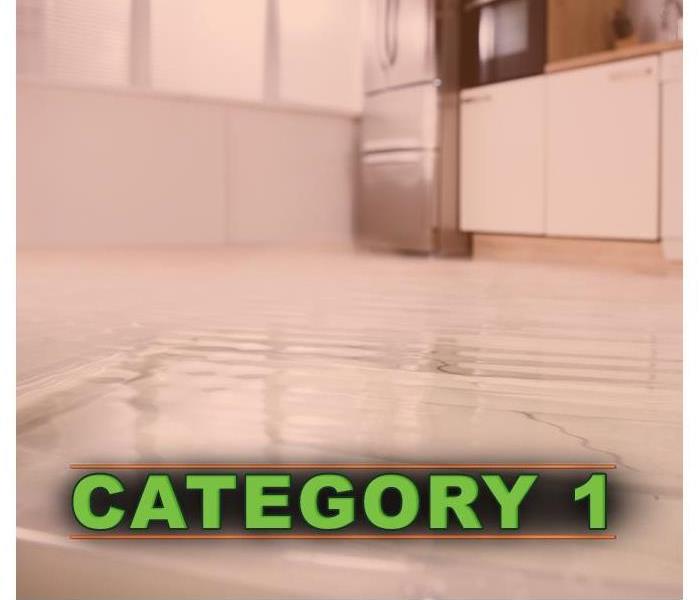 Clean water coming out of a dishwasher in a Hibsaw, OK home
Clean water coming out of a dishwasher in a Hibsaw, OK home
When your home in Hibsaw, OK, floods during a storm, you may think that all you need to do is remove the water and dry it out. All flooding is not created equal, though. The remediation process for damage from storms is different from the process used to handle a pipe break. The reason for this difference is contamination.
Contamination Levels
There are many different events that can cause water damage to your home. The first thing that flood restoration specialists consider when determining how to mitigate the damage is the contamination level of the water:
Category 1 - clean water from pipes or supply lines
Category 2 - dirty water from appliances or bathtub overflow
Category 3 - contaminated water from sewage or storms
Materials damaged from contaminated water cannot just be removed. The remaining parts of the structure also have to be cleaned to rid them of bacteria and other microbes. The more bacteria that are potentially present, the more in-depth the cleanup process needs to be.
Contamination Reach
The immediate area where the flooding occurs is not the only place that needs disinfection when technicians are tackling storm damage. The high winds that accompany storms can carry bacteria throughout your home. A thorough cleaning of all surfaces, including those in the air vents and crawl spaces, helps ensure that your home is free of contamination when the restoration is complete.
Contamination Effects
This thorough approach stops flood damage in its tracks. Disinfecting every surface after a storm helps prevent secondary damage, which can manifest as either mold patches or more water damage. The sooner your home can be cleaned, the more successful you will be at avoiding further problems.
Flooding from a storm can leave your home vulnerable to contamination, but professional cleanup can take care of it. By taking the necessary extra steps to make sure your home is not only dry but clean, technicians can restore your home to the way it was before the flood.
Clean Your Property and Contents After a Flood
4/3/2020 (Permalink)
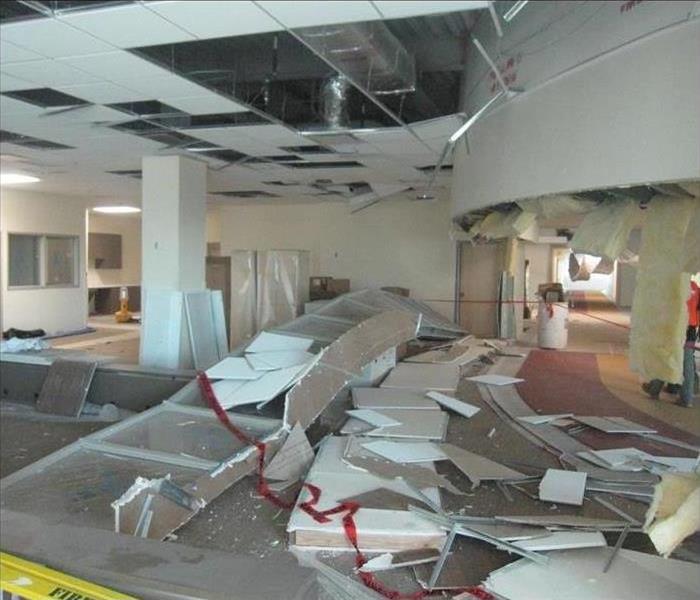 Storm damage in Oklahoma City, OK
Storm damage in Oklahoma City, OK
Cleaning up after a flood in your Oklahoma City, OK, business can seem overwhelming, but with preparation and planning, you can steadily deal with the damage. Reach out to available resources and take the following content cleaning steps to get your business back on track.
Focus on Safety First
There are several significant risks when dealing with water in the workplace. Before you start any cleanup effort, protect yourself and those around you from potential hazards.
- Turn off the gas and electricity.
- Use appropriate protective gear, such as gloves, boots, and masks.
- Contact flood cleanup professionals immediately if you suspect black water.
- Remove water as quickly as possible.
Whether water trickled into your building or rushed in quickly, there's a potential for damage to the foundation, walls, floors, windows, and other structural components. Before stepping onto a weakened floor, make sure there aren't dangerous structural damages.
Document Water Damage for Your Insurance
After taking care of your first priorities, it's important to document damages for your insurance company. Take photographs or video of the damages to your building. These should be taken before you start to clean up any of the flood damage.
Identify DIY Work and Professional Work
You can take care of a lot of cleaning and damage, but some of the work should be completed by professionals. For example, soggy books and papers, damaged artwork, and furnishings may require the specialized care that professionals provide. Your insurance company may prefer that you turn all of the cleanup over to these technicians. Professional-strength cleaners and disinfectants remove layers of dirt and slow or prevent the growth of diseases from black water contamination.
There are many surfaces and materials in your building that require specialized content cleaning efforts. Protect your property from lasting damages, such as mold growth and structural damages, by taking prompt action, working with your insurance company, and determining which tasks to turn over to professionals.
What You Need To Know Before Cleaning Up Water Damage
10/26/2019 (Permalink)
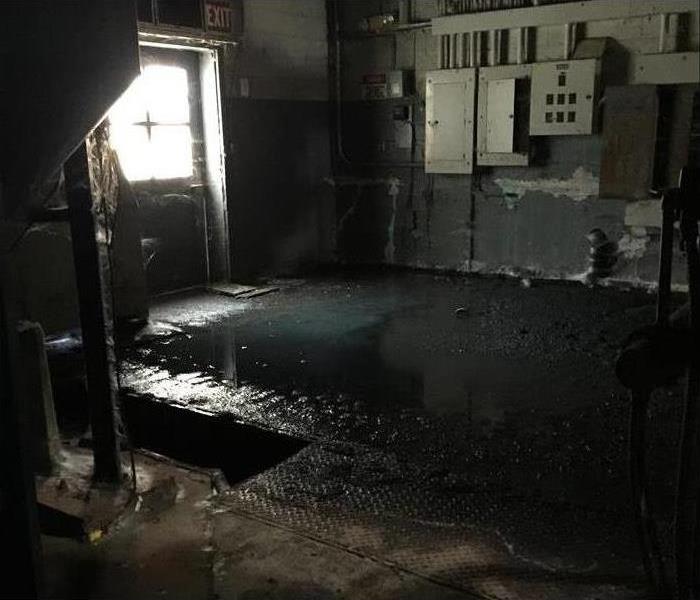 Commercial flooded basement in Arcadia,OK
Commercial flooded basement in Arcadia,OK
Water is an essential resource, but it can be destructive when it flows where it doesn’t belong. When water damages your business, it is important to determine the source of the problem. This discussion of three common sources may help you decide how to proceed with your structural and content cleaning.
Facility-Related Water
When damage is caused by a water source within your building, it may have originated from one of these sources:
- Your refrigerator or water heater leaks.
- A pipe carrying clean water bursts in your building.
- A dishwasher or specialized piece of equipment leaks water that may be contaminated with chemicals, soil or food.
- A toilet overflows or a sewer backs up, releasing sewage into your structure.
If the water potentially contains toxic chemicals or sewage, it is considered to be dangerous. Consulting a water remediation specialist will be required to safely facilitate the content cleaning and restoration. Facility-related damage is likely covered by your insurance, so contacting your agent promptly is recommended.
Stormwater
When hail, rain or snowmelt enters your building through a broken window or leaking roof, it is considered stormwater. If the water hasn’t touched the ground and is due to a weather event, it falls into this category. Stormwater damage generally requires a professional cleanup service as well as home repairs. Your business insurance will generally cover the expense for stormwater restoration.
Floodwater
If rising floodwater enters your building at ground level or below, it is termed black water and is considered highly contaminated. Floodwater can contain chemicals, sewage and other hazards. If you have flood-related damage, it is necessary to enlist a restoration specialist for the building and content cleaning process. For this water restoration cost to be covered, you would need to have purchased a separate insurance policy for flooding, prior to the incident.
When water from a flood or other source damages your Arcadia, OK, business, the origin of the water will determine the best cleanup plan and the type of insurance coverage that applies. It will take some time, but before you know it, your company will be back to business as usual.
How to Deal With Mold Damage After Flooding
9/10/2019 (Permalink)
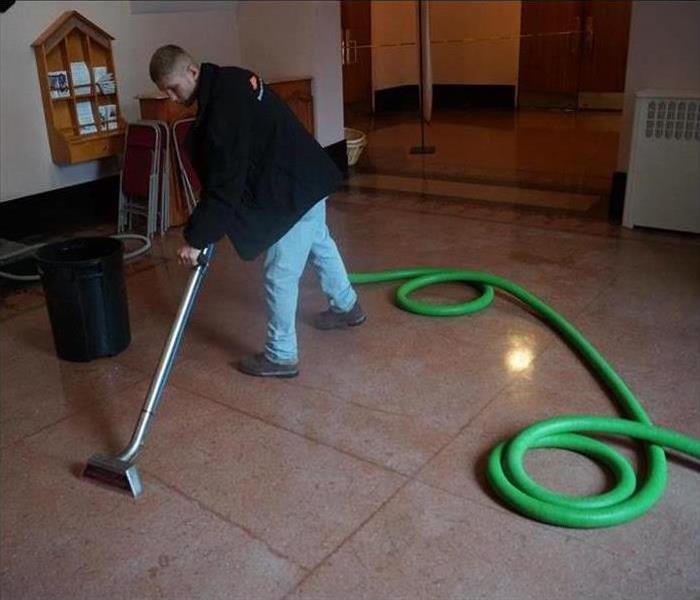 Clean up after storm damage in Oak Tree, OK
Clean up after storm damage in Oak Tree, OK
Combat Mold With These Helpful Tips
Hurricanes, tornadoes and floods in Oak Tree, OK, can deal significant water damage to your house. This could lead to mold and mildew making its way into your home. Stay on top of the wellbeing of your residence and combat mold growth with these helpful tips:
1. Ask the Experts
After your home has been flooded or exposed to standing water, it is very likely that mold will begin to develop quickly. The best thing to do would be to contact a reliable company that specializes in mold remediation. They will perform clean up and restoration of your flooded home. You can rest easy with the peace of mind that your home is completely safe for occupancy.
2. Stop Mold in Its Tracks
Mold can start to grow between 24-48 hours in the right conditions. It's important to move quickly if your home has been flooded. The first step to preventing mold growth is a thorough cleanup process. Start by removing water from your home, ensuring that all excess moisture that is the breeding ground for mold is sucked out of porous surfaces. Clean and disinfect your home thoroughly. Discard any items that have sustained extensive water damage.
3. Stay Alert
It’s easy to relax once your home has been cleaned up and disinfected after a flood, but its best to stay vigilant in the upcoming weeks for any sign of bacteria and mold due to lingering moisture. Flood water can saturate the area surrounding your house and affect the basement and foundation. Be on the lookout for spores or a musty odor that can signify the presence of mold.
Mold growth in your residence may sound like a nightmare, but it’s easy to get ahead of if you are attentive and move quickly. You don’t have to handle it on your own. If mold control in your home gets to be too overwhelming, reach out for the support of professionals that can lend their expertise in ensure your home is mold-free.
2019 Storm Recovery Checklist
7/9/2019 (Permalink)
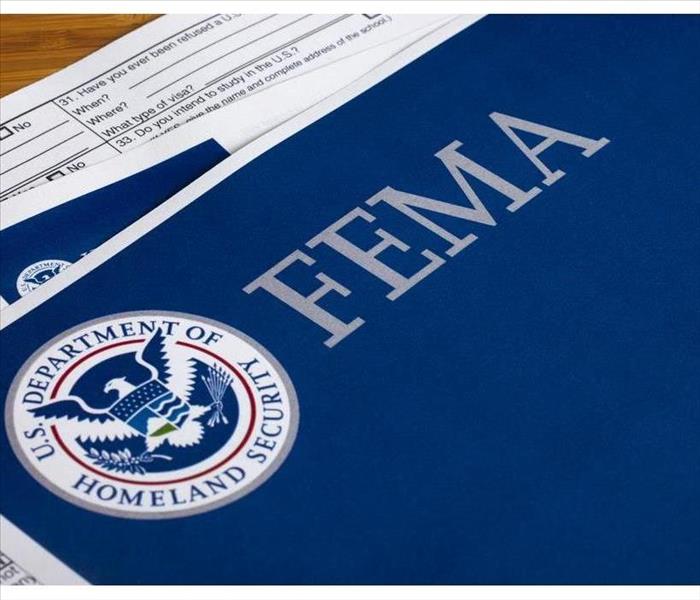 If you find yourself in a disaster situation, remember that FEMA can help
If you find yourself in a disaster situation, remember that FEMA can help
FEMA
Sometimes, the weather gets the better of us, and we are left dealing with the repercussions. Thankfully, there are many programs that help people recover after heavy storm damage such as FEMA. Whether you live in Hibsaw, OK, or somewhere different altogether, the same basics can be helpful for coping with a stressful time. The location should only matter in paperwork.
1. Submit for Help
After the damage has occurred, whether from a flood or otherwise, you can submit an appeal to FEMA for assistance. Consider these first:
- You must have a United States citizen in the household.
- Your property is in an area that has been
- Presidentially declared a disaster.
- Your insurance does not cover necessities that the disaster has brought about.
If you do not submit to the organization, you may find yourself in a bad position. There should be no shame in asking for help when needed. Flooding, and other disasters, are a time when we can pull together. Other organizations can be contacted to help once you are safe and everything is accounted for to repair.
2. Inspect Your Home
A scheduled home inspector can come and see your property within 10 days of the submittal. You can expect the inspection to run on average for 30 minutes, and the inspector may photograph your property. This will include both your home and the items inside. You may be asked to present documentation on whether you own or rent.
3. Accept the Assistance
Afterward, assistance may be released to you. This can come in the form of lodging reimbursement or renting assistance to keep you housed. It can also extend further through financial assistance with replacing household items, childcare, funeral expenses, or healthcare. Finally, you may be assisted with storage.
If you find yourself in a disaster situation, remember that FEMA has been set up to help for these purposes. Make sure to submit the right paperwork and prepare for a home inspection.
Yard Water Management
4/26/2019 (Permalink)
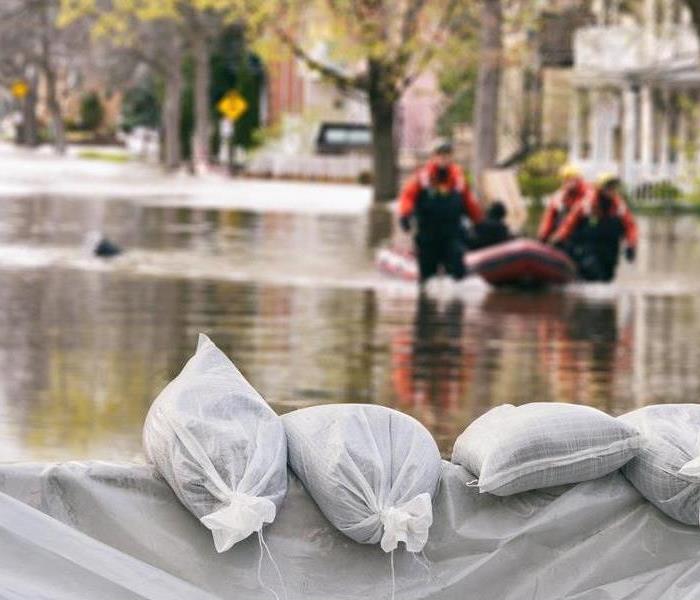 Many outside flooding issues can be resolved with minor alterations to existing lawn and garden practices.
Many outside flooding issues can be resolved with minor alterations to existing lawn and garden practices.
Weather conditions are widely variable in Edmond, OK. Discover how to control outside flooding and protect your property with a few simple landscaping practices.
1. Roof and Gutter Changes
One of the easiest fixes for excess water pooling around the home involves proper roof and gutter maintenance. If shingles are in disrepair or the gutters are clogged, this can prevent water from flowing cleanly off the roof and through the downspout during a rain storm. This means that rain can spill directly down near the house and seep into the foundation, basement, and crawlspace. In turn, this may require you to contact a flood cleanup service. Prevent this with proper roof inspections, yearly gutter cleanings, and downspout designs that deposit the water farther away from the base of the house.
2. Slope Control
Homes are typically built such that the soil slopes downward toward the border of the property, directing the water flow away from the home. If you notice outside flooding or any type of pooling, purchase additional topsoil or gravel to change the grade of your yard at that location by simply filling in the hole. If the water flow is excessive, it may be beneficial to dig a shallow drainage canal instead, bordered by slightly raised land on either side. These sloping variations are called swales, and can subtly solve rain drainage problems without disrupting the visual elements of your landscaping.
3. Surface Materials
Some ground cover materials are more suitable for wet conditions than others. If you have clay or silt soil, you may have noticed that running water tends to erode channels in your yard and prevent grass from growing in some locations. Plant sturdier shrubs and use heavy mulches or gravel to keep your topsoil layer from slowly washing down the storm drain.
Many outside flooding issues can be resolved with minor alterations to existing lawn and garden practices. Observe how water tends to flow through your property and make corresponding landscaping adjustments.
Wednesday Tornadoes Hit Arkansas and Oklahoma
2/25/2019 (Permalink)
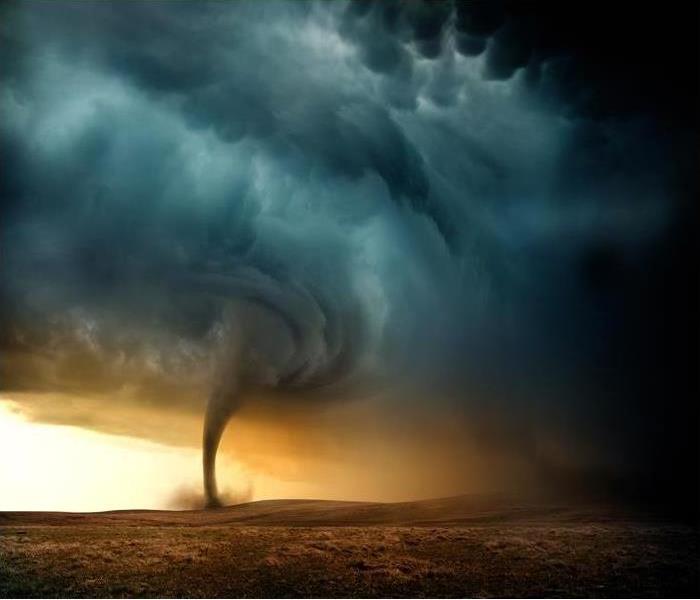 Tornado in Tulsa, OK
Tornado in Tulsa, OK
Arkansas and Oklahoma
The nation's slow start to tornado season reached a devastating conclusion Wednesday night in Tulsa, OK when winds hit the city during rush hour and left one citizen dead and several injured.
The Tulsa County Sheriff's Capt
Bill McKelvey announced that one person was killed in a residence of a Sand Springs mobile home park which was nearly destroyed due to the weather. It was not clear whether the tornado itself or straight-line winds caused such damage to the mobile home park, which according to McKelvey contains 40 to 50 mobile residences. "It could have been much worse," McKelvey said after stating that several people had been confirmed injured, though the exact number was uncertain.
The U.S. had gone a month tornado-free until Tuesday when a waterspout formed over a lake in Arkansas. Television footage captured the tornado as it swept through parts of Moore and showed some of the roof damage houses suffered as a result of the strong winds, some of which were scraped to their foundations from the storm two years prior.
In Tulsa, a glass door at the building which houses the National Weather Service's office was shattered, and several cars parked out front lost their windows. Resident Don Ruffin said that he and a neighbor were at a convenience store in southwest Moore when he caught sight of the tornado approaching. “I don’t know how close it was to us, but it looked like it was coming toward us, and so we didn’t take any chances,” Ruffin said. “We got in our vehicles, ran home and got in our shelters.”
He recalled that after the storm passed there was "patio furniture thrown everywhere," and that some houses had their fences knocked down. 27,000 homes and businesses were reported to be without power in Oklahoma City by electric companies, and 28,500 had lost power throughout Tulsa. According to the Oklahoma City Highway Patrol, a tractor trailer had overturned, causing a massive traffic jam in both directions of Interstate 35, a major north-south route. “Those troopers are working their guts out there right now,” Lt. John Vincent said.
After a quiet start to what is usually a hectic and destructive season, southerly winds pushed temperatures into the 70s and 80s through the Ozark Mountains and southwestern plains, where weather fronts churned the air into the storm's that hit Wednesday.
Greg Carbin, warning coordination meteorologist for the Storm Prediction Center in Norman, Oklahoma, said that Wednesday's storms "will be the ‘tornado’ that breaks the drought for March."
Only about two-dozen twisters had been reported in total this year before this past week's massive storm, a startlingly low number during a period in which the average is 120. The last time the U.S. had no twisters in the month of March was nearly 50 years ago, according to figures obtained from the Storm Prediction Center.
SERVPRO Storm Damage Cleanup & Restoration
When a natural disaster strikes it can be all too easy to lose hope in light of severe damage and loss. Whether it’s a tornado, hurricane, blizzard or flood – the SERVPRO Disaster Recovery Team can provide help fast.
How to Remove Odors After Flooding
2/25/2019 (Permalink)
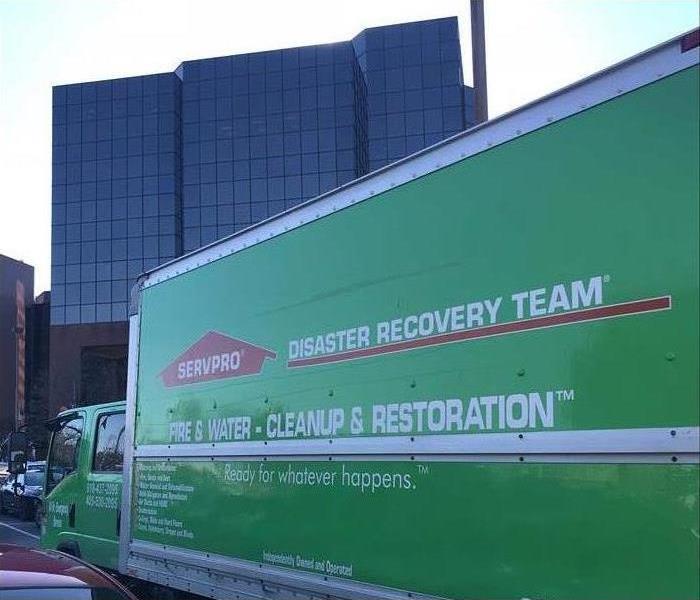 Hire a professional water damage remediation service in Edmond, OK
Hire a professional water damage remediation service in Edmond, OK
How to Remove Odors After Flooding
Even a relatively small flood can result in mold growth. As a result, an unpleasant, musty odor can develop that permeates your entire building. Flood water results in sewage loss within the building’s septic system, which can make the smell even worse. The best way to make your building smell right again is to hire a professional water damage remediation service in Edmond, OK.
1. Dry the Flooded Area
Any standing water will need to be removed via sump pump first. For the remaining dampness, professionals will bring in heavy-duty floor fans to promote air circulation. It is also a good idea to keep the windows open during this process and for several hours afterward. Dehumidifiers can also help with removing moisture from the air.
2. Take Note of Lingering Odors
As part of the water damage restoration process, professionals will remove items too badly damaged from mold growth to remedy. This can include panels of drywall or flooring. This should help with getting rid of some of the odor, but you need to pay attention after the crew leaves because certain smells may remain. Spread baking soda over the flooring and vacuum it up the next day to take care of some odors. In the event nothing else works, you should contact the restoration service in City, State to come back to see if mold grew in other areas.
3. Enhance Overall Air Quality
Indoor air quality is critical to people’s well-being. You should replace furnace and air filters once every three months. It may also be good to acquire a high-efficiency particulate air filter to remove substances that entered the air through flood water. Mold growth can lead to serious health complications, so if people in your commercial building smell something, it is important to act. Always allow a professional service to address any odors first before handling it yourself because the wrong step could exacerbate the underlying problem.
Visit http://www.SERVPROedmond.com for more information on odor removal.
Getting Ready for the Worst: Disaster Preparedness Tips
2/12/2019 (Permalink)
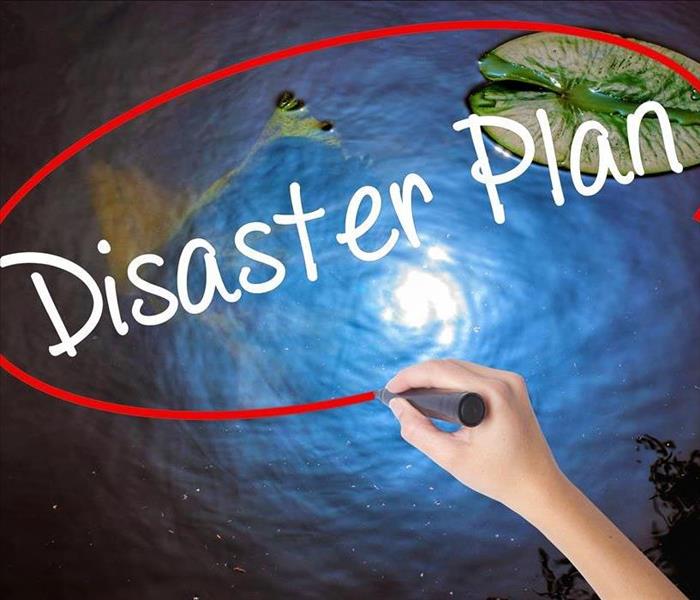 A good preparedness plan ensures your business.
A good preparedness plan ensures your business.
How quickly can your company can get back on its feet after a tornado, fire or flood? If you don’t have a disaster preparedness plan, the answer is probably not very fast. Emergency plans aren’t often top of mind when the weather is good, but that’s exactly when you should prepare. Ensure your Edmond, OK, business is ready to weather the worst in the future by following these tips today.
Learn the Risks
Disaster risks are posed by events both man-made and naturally occurring. Some of the top things to plan for include the following situations:
- Hurricanes
- Tornadoes
- Terror attacks
- Flooding
A good preparedness plan should be effective across all the above and more. Below are a few tips to get you started.
Create a Business Continuity Blueprint
Figuring out how to keep your organization on its feet during disaster is a key, but often overlooked, part of disaster preparation. Start by identifying your business’s critical operations. Determine which staff roles are crucial to keeping your company afloat and which suppliers, shippers and resources are integral to daily business.
Stash Emergency Supplies
Think about the basics as you prepare a storm supply kit. In addition to basic first aid items, your disaster preparedness kit should contain these necessities:
- Fresh water
- Flashlight with batteries
- Whistle to signal for help
- Battery-powered commercial radio
- Moistened towelettes
This is just a start. Evaluate your unique needs and build out your business preparedness kit throughout the year.
Secure Your Property
When a storm is imminent, taking basic steps to secure your property can reduce damage. Invest in wind shutters or board windows with plywood. Move garbage bins, furniture and other potential projectiles indoors and secure lids and other moving parts on items that can be brought inside.
Disaster preparedness isn’t glamorous, but it is necessary. Use these tips from top storm preparedness experts to ensure your business isn’t wiped out.
Storm Damage Versus Water Damage Cleanup: What's the Difference?
9/14/2018 (Permalink)
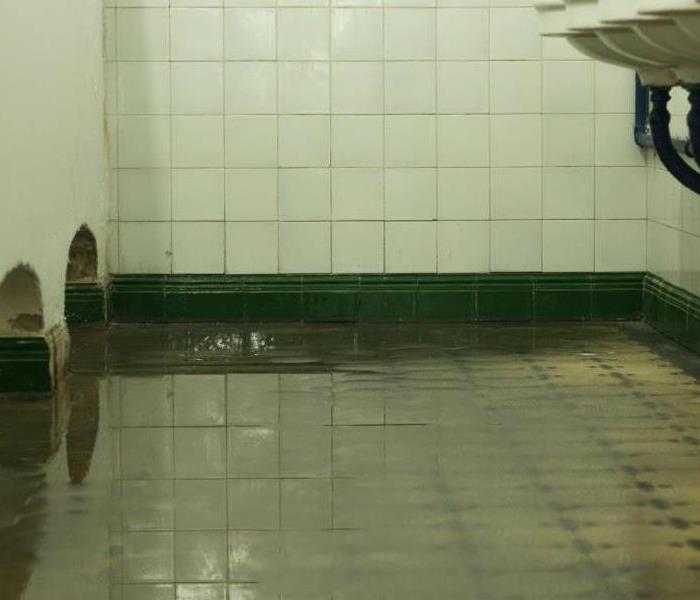 When dealing with Category One damage, the best approach is to quickly eliminate water and moisture that may lead to mold.
When dealing with Category One damage, the best approach is to quickly eliminate water and moisture that may lead to mold.
Storms, flooding, and leaks can all damage your home. While water is the source of the damage in all of these situations, the major difference is the category of water involved. Find out about the three categories of water damage and how cleanup varies between storm damage, flood damage, and leaks.
• Category One water is clean and treated. A burst supply pipe is the most common source of a Category One leak.
• Category Two water is also known as gray water. This water may contain bacteria or chemicals but not sewage or solid waste.
• Category Three water is sometimes referred to as black water. Black water is the most common type involved in flooding, and is highly contaminated.
The cleanup procedures necessary for these categories of water damage vary.
Category One Cleanup
The water involved in a category one leak is clean and treated. As bacteria is not a concern, the only cleanup procedures necessary involve eliminating any standing water and thoroughly drying the affected area. You may still want to rely on fans and dehumidifiers to dry the area more quickly and prevent mold from forming.
Category Two Cleanup
Category Two cleanup should involve cleaning and disinfection as well as thorough drying. This type of backup or leak is not as severe as damage from a flood or sewer backup.
Category Three Cleanup
Floods and severe sewage backups involve black water containing solid waste. Cleaning and disinfection is necessary to limit infection risks, and the area must be completely dried to prevent mold.
When dealing with Category One damage, the best approach is to quickly eliminate water and moisture that may lead to mold. Most flooding and storm damage cleanup involves black water and requires cleaning and disinfection in addition to drying. Resolve any situation as soon as possible by contacting a flood damage restoration company in Edmond, OK. For more information, visit http://www.SERVPROedmond.com/.
What Is FEMA?
7/16/2018 (Permalink)
 When a flood strikes in Edmond, OK, and you do not have flood insurance, there is another option for help.
When a flood strikes in Edmond, OK, and you do not have flood insurance, there is another option for help.
Have you heard of The Federal Emergency Management Agency (FEMA)? Many homeowners in Edmond, OK, are not aware of this support system for victims of domestic disasters. Every year the most common, and expensive, national disaster is flooding. Even without flood insurance, people impacted by flood waters can get some monetary relief.
What Options Does FEMA Offer?
Renters, homeowners and business owners have the choice to purchase a policy directly through The National Flood Insurance Program. This is a good decision if your home is located in a flood plain. However, even if you are not covered, there are two additional options to help fund flood damage repair of your home and property:
• You can apply for a grant, which does not need to be paid back. This money is for disaster-related expenditures such as emergency repairs to your home or short-term housing while your house is unlivable. Grants are not intended to fund complete restoration, but rather help you to return your home to a safe condition.
• A disaster loan does need to be paid back. However, you can borrow enough money to completely restore your home to pre-flood condition.
How Do Homeowners Access Support?
• You are eligible for this program when a declared disaster causes damage to your home or property. A member of your household must be a US citizen or qualified alien. You may be eligible for other types of assistance if the members of your home are undocumented.
• Apply for grants or loans at https://www.disasterassistance.gov.
• An inspector contacts you and inspects the damage. The next step includes working with a qualified flood and water restoration specialist who restores your home and personal property.
When a flood strikes in Edmond, OK, and you do not have flood insurance, there is another option for help. FEMA offers disaster relief funding in the form of grants and loans to help you get back on your feet after a flood or other domestic disaster. For more information, visit http://www.SERVPROedmond.com/.
The Importance of a Business Continuity Plan
6/14/2018 (Permalink)
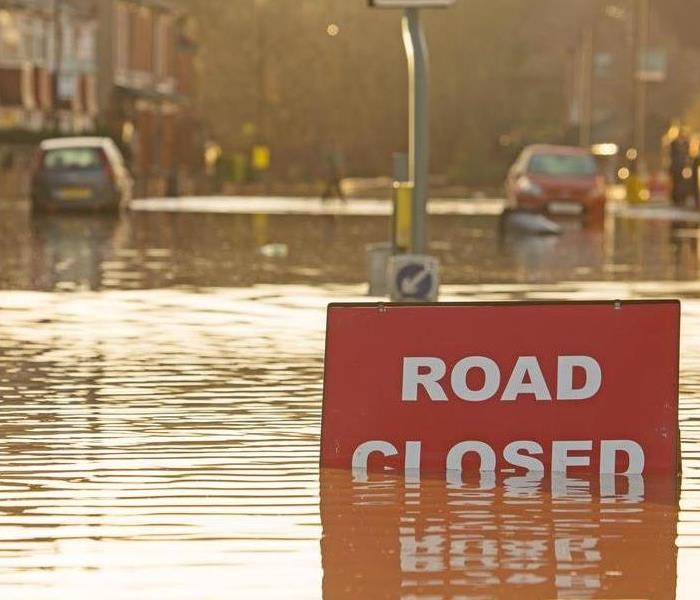 One cannot control mother nature, but one can reduce the financial impact a flood or other storm ultimately has on one's business.
One cannot control mother nature, but one can reduce the financial impact a flood or other storm ultimately has on one's business.
Storm damage can wreak havoc on one's business, as not only can it result in extensive and expensive property damage, but also, it can result in business closure. If all or part of your building was rendered unsafe post-flooding, you risk not being able to go about business as usual. Not only is that bad for profits, but also, it may mean that your customers turn to competitors to fulfill the needs that you usually satisfy. Fortunately, you can prevent such financial devastation with a business continuity plan.
The Importance of Business Continuity Planning
You may have insurance in place to cover property damage and lost equipment, but insurance does not cover lost profits or replace lost customers. Keeping customers and ensuring ongoing profit is up to you. You can help reduce the impact of flooding or some other major disaster by following three simple steps.
1. Perform a Business Impact Analysis: Identify critical business functions and processes and make note of the resources necessary to support them.
2. Put Together a Business Continuity Team: People are your most valuable resources. In order for your continuity plan to be successful, you must have the right people on hand to carry it out. Select members of your team who are most likely to successfully manage a business disruption.
3. Train Your Team: Finally, train the team you put together. You never know how people will react in the face of disaster. The best way to prepare everyone for a hiccup is to train them for one.
Reduce the Impact of Disaster
One cannot control mother nature, but one can reduce the financial impact a flood or other storm ultimately has on one's business. Though you can't stop a flood from damaging your building, you can make the most of a bad situation by having a business continuity plan in place. Talk to your local Edmond, OK, storm damage remediation team about what other considerations you need to make when creating your plan. For more information, visit http://www.SERVPROedmond.com/.
Using Landscaping To Protect Your Home During Storms
4/19/2018 (Permalink)
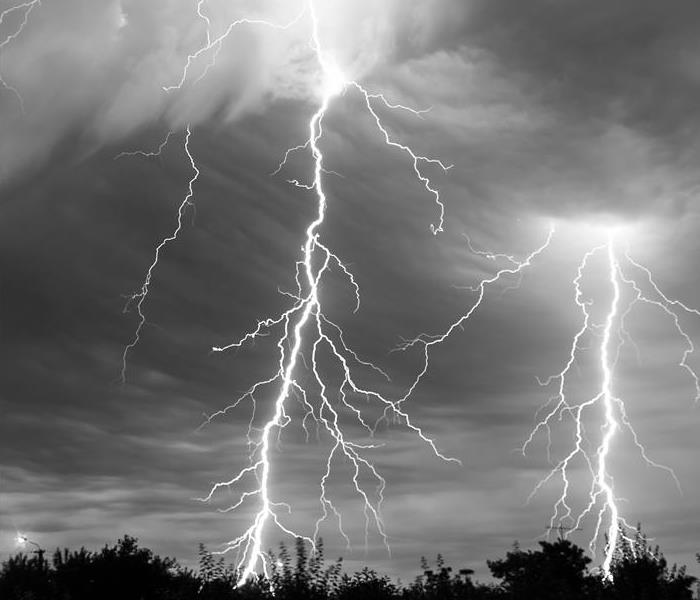
In the last several years, storms have increased, causing a frequency in the number of hurricanes, tornadoes, and thunderstorms being seen across the nation. Any of these weather disturbances can promote outside flooding, escalating the risks for damage to home structures. Homes can suffer loss due to flooding in several ways:
• Corrosion of roof
• Cracks in foundation
• Damage to windows and door jams
• Softening of drywall
• Mold occurring due to prolonged moisture
• Swelling of frame
• Damage to flooring
Although the climate cannot be controlled by homeowners, it is possible to prevent damage to property by taking certain measures.
Diverting Water With Rain Spouts
If you experience a severe rain storm in Edmond, OK, our home could be subject to outside flooding causing damage. One of the most common problems relating to rain drainage is the improper installation of rain spouts. This can be a simple yet often overlooked way to prevent water from entering your home. Downspout diverters can keep water away from walls and from saturating into lower ground near the foundation.
Using Heavy Mulch
Mulch varies according to its type and can benefit your landscape if you select the right kind. Using a light wood consisting of small chips or nuggets can result in abandonment as the mulch is likely to wash away with the rain. Heavier nuggets containing hardwood should stay put and keep the soil below it in place. Another effective choice is shredded bark or wood since the pieces intertwine with each other.
Creating Swales
A swale is a lower tract of landscape that can redirect water in times of flooding. Sloping the ground away from the house creates a natural deterrent of water. Make sure you channel rain drainage to a place that can tolerate the increase and be sure it remains on your property.
After mitigating consequences of outside flooding, it’s good to keep the name of a qualified flood restoration specialist on hand. This can help you be better prepared in case damage occurs to your home after a storm. For more information, visit http://www.SERVPROedmond.com/.
Why You Need Professional Storm Damage Restoration
2/18/2018 (Permalink)
Are you facing a flooding, river flooding or hurricane damage situation in your home?
Dealing with flooding, storm damage, river flooding or other forms of natural disasters can be a frustrating and difficult experience and needs to be handled properly. If the storm is too severe, the hail damage and frozen pipes could result in huge repair costs.
Not sure what to do about flood water, roof leak or wind damage?
When a home sustains damage due to storm, ice damage, frozen pipes, flooding, ice dam, river flooding, ice damming, hail damage or wind damage, homeowners are advised to hire professionals to provide storm restoration or water restoration.
Professionals are skilled in handing storm damage, hurricane damage and their devastating effects and can assess the hurricane damage, wind damage, flood damage and other storm damage related situations that occurred during the storm. They have the right equipment and are experienced in ice damage, frozen pipes, ice dam, ice damming and storm restoration.
SERVPRO of Edmond has more services. Visit www.SERVPROedmond.com for more information.
What can I expect from the restoration process?
2/18/2018 (Permalink)
The restoration process involves removing the water from flooded basement, furniture, walls, carpet, or walls.
Trained technicians from a restoration company use flood pump and the latest water cleanup and drying equipment and state-of-the-art technology. Their high-power equipment, flood pump and advanced techniques enable them to get rid of flood water, ground water and debris and clean a flooded home faster. Their aim is to prevent additional water in the property or water damage and ultimately restore the home back to good condition quickly.
Call a water restoration company once your home has suffered roof damage, ice damage, frozen pipes, hurricane damage, hail damage, river flooding, roof leak, ground water or flood water. Water restoration professionals know what to do and how to do it properly in order to achieve successful home restoration.
SERVPRO of Edmond has more services. Visit www.SERVPROedmond.com for more information.
How to Prepare When a Storm Is in the Forecast
1/10/2018 (Permalink)
You should know well in advance when a storm is going to blow through Edmond, OK. While there is only so much you can do to prepare and protect your home, you should still take action to do everything possible to prevent flood water from entering your abode and water damage from harming your property, because a completely flooded building is the last thing you need to deal with.
1. Learn How to Shut Off Electrical and Water Supply
If you do not currently know where your circuit breaker and water main are located, then you need to find them on your property. You should turn off the power if your block experiences a power outage. You want to shut everything off because in the event power is restored, the sudden burst of energy could overload the system, resulting in significant damage to electrical appliances. You should also turn off all utilities right before you have to evacuate, if necessary.
2. Relocate Valuables
Keep any precious heirlooms out of the basement, which is most susceptible to flood water. You also want to keep valuables away from doors and windows, because they are entry points by which water or winds can enter.
3. Trim Trees
When you have several weeks’ notice of an oncoming storm in Edmond, OK you should consider hiring a professional service to trim and prune trees that are too close to your home. A diseased tree or weakened branches can break off and strike a building.
4. Move Lawn Accessories Outside
With strong enough winds, outdoor ornaments and furniture can become projectiles. Move them inside for the time being, or secure them outside by using a bungee cord or cable.
5. Maintain Gutters
Your home’s gutters help keep flood water away from the siding and foundation of your house. Remove leaves and other debris from them regularly so water does not become impeded. Visit http://www.SERVPROedmond.com for more information on storm damage.
Flood Damage in Edmond, OK
12/15/2017 (Permalink)
Any person who has experienced water damage in Edmond from a burst pipe in their home probably understands how stressful such an event can be, not to mention how expensive. Not only is the Edmond homeowner's schedule and life on hold until the issue is addressed, damaged items must be replaced, before insurance claims must be filled out and submitted in Oklahoma. In addition, mold and mildew may compound the problem if not treated immediately. Fortunately, professional water damage experts in Oklahoma City are available to provide helpful services for those who have such problems.
Leaking Pipes
Tulsa homeowners should pay close attention to leaks in pipes and other plumbing problems that may create a constant source of moisture within the Tulsa dwelling. Prompt repairs must be made when a leaky pipe is found. However, only professionals are qualified to evaluate moisture problems, and it is never wise for property owners to try to diagnose the situation or make guesses concerning where the location of the problem is.
Preventing Structural Damage in Yukon, Oklahoma.
Any consumer dealing with water damage in Yukon, regardless of its source, must understand that procrastinating is never wise. One of the biggest dangers regarding the presence of water or moisture in the home is structural damage. When a Yukon dwelling sustains such damage, it must be dealt with promptly as it will only become worse if ignored. Therefore, having the damage accurately assessed by a contractor is essential.
Mold Hazards
Mold is often referred to as the worst type of water damage in Bethany. The reason for this is probably because of how difficult it is to eradicate. The presence of mildew or mold damage can result in serious health problems for anyone residing in the Bethany home. The cellulose used to manufacture drywall is a favorite location of mold spores, which proliferate quickly in such areas. Homeowners should look for mold and mildew on a regular basis in areas that are typically damp, such as laundry rooms and basements especially in Bethany. A mold inspection should be completed immediately after a water moisture problem in the home has been detected.
Additional Considerations
Attempting to deal with water damage from a burst pipe in Mustang without professional assistance is unwise. Few homeowners have the skills to repair such damage on their own. If they attempt to do so, they may inadvertently make the problem worse, leading to expensive repairs in the future. In Mustang, it is best to hire a water remediation company experienced in a broad range of moisture problems since they may provide services such as mold remediation, carpet cleaning and upholstery cleaning, and water removal. An experienced company will provide a complete evaluation of the water damage, including a monetary estimate for the necessary repairs. It is wise to gather several estimates before hiring a water damage company. It is also important to ask the company if their staff members are certified in water damage repair. Because your home is your major investment, addressing water and moisture problems in a timely manner should be your top priority.
Water damage from storms
12/15/2017 (Permalink)
Home can be impacted by the damaging waters of a flood due to a number of causes. Heavy rains cause flooding typically, such as from a hurricane or another severe or torrential storm. Flooding may also occur due to a major plumbing issue or for other reasons. The unfortunate truth is that standing or rising water inside a home can cause a significant amount of water in a short period of time. There is often a need to remove the water quickly, if possible. Then, the significant task of flood damage Edmond repair can begin. Finding the right company to perform the repair work is important, and you can pay attention to a few points to find the best company for the job.
The Type of Services Available
When water enters your home, it can impact almost every surface. Drywall and wood features can become warped and may even rot or decompose. Fabrics and upholstery may become stained and moldy. Electrical work may go on the fritz. These are just a few of the ways that water can impact a home, and all will need to be remedied before the repair work can be completed. Some items may be salvaged, but others will need to be fixed or replaced. The best results will be from a company that is focused on restoring the property to its former condition or better in a timely manner. The company may need to offer water remediation services if water is still in the home, and advanced equipment should be used to ensure thorough results. In addition, a full approach to repair work, including working with your insurance company to file a claim, is important.
A Certified Company
While there may be several companies in your local area that offer repair services, the fact is that you do not want to trust just any company with this important project. Instead, you want to work with a certified company that has a great reputation. Look for a company that is affiliated with or certified by the Institute of Inspection Cleaning and Restoration Certification, or IICRC. The certification to look for is the Cleantrust certification. In addition, while you should act quickly to schedule service with a flood damage repair company, you should also spend a few minutes reading consumer reviews to determine if the company is known for providing fast, quality work.
An Immediate Response with Focused Effort
When you contact an Edmond Flood Damage repair company for assistance, you should inquire about availability. The company ideally will offer around-the-clock service if you are dealing with a flooding issue in your home. You typically only have a number of hours to dry out the home before the potential risk for mold growth increases, so a timely response is imperative. In addition, inquire about the steps the company will take to follow through on the work and about what finished results you should expect and the anticipated time frame. Flood damage repair can be significant, and the process may be lengthy. However, the company should be focused on working on your home until the work is completed.
At the first sign of a flood in your home, you should begin searching for a reputable company to use for flood damage repair services. When you focus on these factors, you can expect superior results.
SERVPRO of Edmond is locally owned and operated and serves Oklahoma City, Tulsa, Edmond, Stillwater, Yukon, Bethany, Mustang, Moore, Guthrie, Choctaw, and the surrounding communities
SERVPRO of Edmond’s fully certified water removal staff can perform a complete damage assessment to your home of office, and then recommend and follow the industries standards to get your water removal restoration repaired properly available 24 hours a day.



 24/7 Emergency Service
24/7 Emergency Service































